
DEPARTMENT OF THE AIR FORCE
Headquarters US Air Force
Washington, DC 20330-1030
3F2X1 CFETP
Parts I & II
21 April 2023
AFSC 3F2X1
Education and Training
CAREER FIELD EDUCATION
AND TRAINING PLAN
ACCESSIBILITY: Publications and forms are available on the e-Publishing
website at www.e-publishing.af.mil for downloading or ordering.
RELEASABILITY: There are no releasability restrictions on this publication.

i
CAREER FIELD EDUCATION AND TRAINING PLAN
EDUCATION AND TRAINING SPECIALTY
AFSC 3F2X1
Table of Contents
PART I
Preface ______________________________________________________________________ 1
Abbreviations/Terms
Explained
____________________________________________________ 2
Section A - General Information ___________________________________________________ 6
Purpose
Usage
Coordination and Approval
Section B - Career Progression and Information _______________________________________ 7
Specialty Description
Skill and Career Progression
Apprentice (3) Level
Journeyman (5) Level
Craftsman (7) Level
Superintendent (9) Level
Training Decisions
Community College of the Air Force (CCAF)
Career Field Path
Section C - Skill Level Training Requirements ______________________________________ 13
Purpose
Specialty Qualification
Apprentice Level Training
Journeyman Level Training
Craftsman Level Training
Superintendent Level Training
Section D - Resource Constraints _________________________________________________ 15
OPR: 355 TRS/TRR
Certified by: CMSgt Eric Johnson AFCFM (HQ USAF/A1DL)
Supersedes: CFETP3F2X1, 22 Aug 2019
Pages: 78

ii
PART II
Section A - Specialty Training Standard (STS) _____________________________________ 17
Section B - Course Objective
List
_______________________________________________
31
Section C - Support
Material
___________________________________________________ 31
Section D - Training Course Index ______________________________________________ 31
Section E - MAJCOM Unique Requirements ______________________________________ 32

1
EDUCATION AND TRAINING SPECIALTY
AFSC 3F2X1
CAREER FIELD EDUCATION AND TRAINING PLAN
Part I
Preface
1.
This Career Field Education and Training Plan (CFETP) is a comprehensive education and
training document that identifies life-cycle education and training requirements, training
support resources, and minimum core task requirements for this specialty. The CFETP will
provide personnel a clear career path to success and will instill rigor in all aspects of the
career field training.
NOTE:
Civilians and additional duty training managers occupying
associated positions may use Part II to support duty position qualification training.
2.
The CFETP consists of two parts. Supervisors will use both parts to plan, manage, and
control training within the specialty.
2.1.
Part I provides information necessary for overall management of the specialty. Section A
explains how to use the plan. Section B identifies career field progression information,
duties and responsibilities, training strategies, and career field path. Section C associates each
level with specialty qualifications (knowledge, education, experience, training, and other).
Section D indicates resource constraints (i.e., funds, manpower, equipment, facilities).
Section E identifies transition training plans for the 3F2X1 career field.
2.2.
Part II is utilized to identify, plan, and conduct training commensurate with the overall
goals of this plan. Section A identifies the Specialty Training Standard (STS) and includes
duties, tasks, and technical references to support training, Air Education and Training
Command (AETC) conducted training, core task, and correspondence course requirements.
Section B identifies the course objective list. Section C identifies available support materials.
Section D identifies a training course index supervisors can use to determine resources
available to support training. Included here are both mandatory and optional courses. Section
E identifies Major Command (MAJCOM) unique training requirements supervisors can use to
determine additional training required for the associated qualification needs.
3.
Using guidance provided in the CFETP will ensure individuals in this specialty receive
effective and efficient training at the appropriate points in their career.

2
ABBREVIATIONS/TERMS EXPLAINED
Advanced Distributed Learning (ADL) – ADL is an evolution of distributive learning
(distance learning) that emphasizes collaboration on standards-based versions of reusable objects,
networks, and learning management systems, and may include some legacy methods and media.
Advanced Training (AT) – Formal course that provides individuals who are qualified in one or
more positions of their Air Force Specialty (AFS) with additional skills and knowledge to
enhance their expertise in the career field. AT is for selected career Airmen at the advanced level of
the AFS.
Air Force Career Field Manager (AFCFM) – The Air Force focal point for the designated
career field within a functional community. Serves as the primary advocate for the career field,
addressing issues and coordinating functional concerns across various staffs. Responsible for
career field policy and guidance.
Air Force Automated Education Management System (AFAEMS) – The official system of
record for Air Force Voluntary Education data. Each Education Center uses AFAEMS to manage
military members’ education record.
Air Force Enlisted Classification Directory (AFECD) – The official directory for all military
enlisted classification descriptions, codes, and identifiers. The specialty descriptions and codes
will be used to identify each Air Force specialty (valid requirements) and describes the minimum
mandatory qualifications of personnel to fill these positions. The updated AFECD is available on
the myPers website.
Air Force Job Qualification Standard (AFJQS)
– A comprehensive task list common to
all persons serving in the duty position, which describes a particular job type or duty
position.
Air Force Specialty (AFS) – A group of positions (with the same title and code) that require
common qualifications.
Air Force Specialty Code (AFSC)
– A five-digit alphanumeric code with potential prefixes
and suffixes added to identify each career field within the Air Force.
Air Reserve Component (ARC) – This term is used as an overarching term when referring to
both the Air National Guard and Air Force Reserve Component together.
Career Field Education and Training Plan (CFETP) – A comprehensive core training
document that identifies life-cycle education and training requirements, training support
resources, and minimum core task requirements for a specialty. The CFETP aims to give
personnel a clear path. It is the formal training contract between the AFCFM and AETC for
formal accession and life-cycle skills training.

3
Behavior - An activity performed to achieve objectives of the job. Involves observable
(physical) components and unobservable (mental) components. Behaviors consist of the
performance of one or more tasks.
Coaching - Relationship where an uncertified or certified professional coach provides technical
support focusing on development of mentees based on their identified performance need.
Competencies - Observable, measurable pattern of knowledge, skills, abilities, behaviors, and
other characteristics needed to perform institutional or occupational functions successfully.
Competency Model - A collection of competencies that together defines successful performance
in a particular work setting. Competency models are the foundation for important human
resource functions such as recruitment and hiring, training and development, and retention.
Competency models may be developed for specific jobs, job groups, organizations, occupations,
or missions. Some competency models include information about the levels of competence,
mastery, or proficiency required at different occupational levels.
Computer Based Training (CBT)
– The use of computers to aid in the delivery and
management of instruction.
Core Task
– Tasks identified by the AFCFM as minimum qualification requirements for
everyone within an AFSC.
Course Objective List (COL)
– A publication derived from initial and advanced skills
course training standard, identifying the tasks and knowledge requirements, and respective
standards provided to achieve a 3, 5, or 7-skill level in this career field.
Supervisors use the COL to assist in conducting graduate evaluations in accordance with
DAFMAN 36-2689, Training Program.
Critical Task
– A task that requires specific training and certification above and beyond
other tasks. Tasks may be defined as critical either through DAFI, Technical Orders, higher
headquarters, or at any level in the unit.
Deployment Task
– Any tasks identified by higher headquarters for personnel to perform
during deployments, contingencies, or wartime. Deployment tasks may be specified for a
particular skill level or in general across the AFSC. Guidance for using deployment tasks can
be found in the applicable CFETP narrative.
Distance Learning (DL)
– Includes video tele-seminar, interactive video tele-training, video
tele-training, Career Development Courses (CDCs), internet-based instruction (IBI), and
CBT. Includes formal courses that a training wing or a contractor develops for export to a
field location (in place of resident training) for trainees to complete without on-site support
of a formal training instructor.

4
Distributed Training
– Formal courses that a training wing or a contractor develops for
export to a field location (in place of resident training for trainees to complete without the on-
site support of a formal training instructor).
Duty Position Tasks
–
Tasks assigned to an individual to be considered qualified for the
position currently held. At a minimum these shall include all core tasks that correspond to the
duty position as directed by the AFCFM and tasks assigned by the supervisor.
Education and Training Course Announcements (ETCA) – Contains specific MAJCOM
procedures, fund citations, reporting instructions, and listings for those formal courses
conducted or managed by MAJCOMs or field operating agencies.
Experiential Learning
–
Formal and informal experiences (e.g., field exercises, internships, or
simulations), which enhance and expand an individual’s competencies. This type of learning
activity provides challenging environments, broadens perspectives, encourages reflective
thinking, introduces new or enhances existing competencies, and allows for the observation of a
learner’s real-time actions.
Foundational Competencies – A set of accepted and valued competencies (e.g., Airman’s
Foundational Competencies), which enable success across a wide-array of DAF missions, roles,
functions, and duties. Taken from AFH 36-2647, Competency Modeling.
Functional Manager (FM) – Senior leaders, designated by the appropriate functional authority,
who provide day-to-day management responsibility over specific functional communities at the
MAJCOM, Field Operating Agency (FOA), Direct Reporting Unit (DRU), Base Level, or ARC
level. FMs are responsible for ensuring their specialties are equipped, developed, and sustained,
as well as encouraging force development opportunities to meet future needs of the Department
of the Air Force’s mission.
Initial Skills Training (IST) – A formal training course that results in an AFSC 3-skill level
award for enlisted personnel.
Learning Management System (LMS) – A software application for the administration,
documentation, tracking, reporting, automation, and delivery of educational courses, training
programs, materials or learning and development programs.
Master Task List (MTL) – A comprehensive list (100%) of all tasks performed within a
work center and consists of the current CFETP or AFJQS and locally developed AF Form 797
(at a minimum). Additionally, it includes tasks required for deployment and/or Unit Type Code
(UTC) requirements.
myFSS – An enterprise solution to support the Air Force’s goal of providing a centralized place
available for all Airmen & Guardians to proactively manage their career, benefits, services, and
family care–from hire to retire.

5
Occupational Competencies – A set of competencies required of all Airmen within a specific
workforce category (a group of functions requiring similar work, i.e., Engineering). They
describe technical/functional skills, knowledge, abilities, behaviors, and other characteristics
needed to perform that function’s mission successfully (taken from 1
Occupational Survey Report (OSR) – A detailed report showing the results of an occupational
survey of tasks performed within a particular AFS.
On-The-Job Training (OJT) – Hands-on, “over-the-shoulder” training conducted to certify
personnel in both upgrade (skill level award and job qualification) and position certification
training.
Proficiency Training – Additional training, either in-residence or exportable advanced training
courses, or on-the-job training, provided to personnel to increase their skills and knowledge
beyond the minimum required for upgrade.
Qualification Training (QT) – Hands-on performance training designed to qualify personnel in
a specific position.
Qualification Training Package (QTP) – A training aid used to provide step-by-step procedures
toward task completion. Supervisors/trainers must use these and document training in the 623A
during OJT (if available).
Representative Sites – Typical organizational units having similar missions, weapon systems or
equipment, or a set of jobs, used as a basis for estimating average training capacities and costs.
Resource Constraints – Resource deficiencies, such as money, facilities, time, manpower, and
equipment that preclude desired training from being delivered.
Specialty Training
– The total training process used to qualify Airmen in their assigned
specialty.
Specialty Training Requirements Team (STRT) – Forum to determine education and training
requirements by bringing together the expertise to establish the most effective mix of formal and
OJT training for each AFS skill level.
Specialty Training Standard (STS) – An Air Force publication (typically inserted as Part II of
the CFETP) that describes an AFS in terms of tasks and identifies knowledge that an Airman in
that specialty may be expected to perform or to know on the job. Also identifies the training
provided to achieve a 3, 5, 7, or 9-skill level within an enlisted AFS. It further serves as a
contract between AETC and the functional user to show which of the overall training
requirements for an AFSC are taught in formal schools and correspondence courses.
Standard – A predetermined quality or quantity against which performance skills and
knowledge are measured. An exact value, a physical entity, or an abstract concept, the
appropriate authority, custom, or common consent sets up and defines to serve as a reference,

6
model, or rule in measuring quantities or qualities, developing practices or procedures, or
evaluating results.
Total Force
– All collective Air Force components (RegAF, reserve, guard, and civilian
elements) of the United States Air Force.
Training Capability – The ability of a unit or base to provide training. Authorities consider the
availability of equipment, qualified trainers, and study reference materials in determining a unit’s
training capability.
Training Capacity – The capability of a training setting to provide training on specified
requirements, based on the availability of resources.
Training Planning Team (TPT) – Comprised of subject matter experts (SMEs) who are
intimately involved in training development. The range of issues surpasses those covered during
the Utilization and Training Workshop (U&TW).
Training Requirements Analysis – A detailed analysis of tasks for a particular AFS to be
included in the training decision process.
Task Qualification Training (TQT) – Training conducted after chemical, biological,
radiological, nuclear, and high-yield explosive defense classroom training in which individuals
perform wartime mission essential tasks in a simulated wartime environment while wearing full
ground crew individual protective equipment or aircrew individual protective equipment.
Headquarters AF, MAJCOM and local functional area managers identify wartime mission
essential tasks. See AFI 10-2501, Emergency Management Program and DAFI 10-2602,
Countering Weapons of Mass Destruction Enterprise for additional information/ requirements.
Upgrade Training (UGT)
– Mandatory training which leads to attainment of a higher skill
level of proficiency.
Utilization and Training Workshop (U&TW) – A forum of the AFCFM, FMs, SMEs and
AETC training personnel to determine career progression training requirements.
Wartime Course – Comprised of those tasks that must be taught when courses are accelerated in
a wartime environment.
Wartime Tasks – Tasks to be taught in the 3-skill level awarding course when the wartime
courses have been activated. In response to a wartime scenario, these tasks will be taught in the 3-
skill level awarding course in a streamlined training environment. These tasks are only for those
career fields that require them to be applied to their technical training center tasks.

7
Section A — General Information
1.
Purpose
. This CFETP provides the information necessary for AFCFMs, MAJCOM FMs,
commanders, training managers, supervisors, and trainers to plan, develop, manage, and
conduct an effective and efficient career field training program. The plan outlines the
training individuals in this AFS should receive in order to develop and progress throughout
their career. This plan identifies initial skills, upgrade, qualification, advanced and
proficiency training. The CFETP has several purposes—some are:
1.1.
Serves as a management tool to plan, manage, conduct, and evaluate a career field
training program. It is also used to help supervisors identify training, at the appropriate point,
in an individual’s career.
1.2.
Identifies task and knowledge requirements for each skill level in the specialty and
recommends education and training throughout each phase of an individual’s career.
1.3
. Lists training courses available in the specialty, identifies sources of training, and the
training delivery method.
1.4.
Identifies major resource constraints that impact full implementation of the desired career
field training process.
2. Usage.
The plan will be used by MAJCOM FMs, Base Training Managers (BTMs), Base
Functional Managers (BFMs), and supervisors at all levels to ensure comprehensive and
cohesive training programs are available for each individual in the specialty.
2.1.
AETC training personnel will develop or revise formal resident, nonresident, field, and
exportable training based on requirements established by the users and documented in Part II of
the CFETP. They will also work with the AFCFM to develop acquisition strategies for
obtaining resources needed to provide identified training.
2.2.
MAJCOM FMs will ensure their training programs complement the CFETP mandatory
initial, upgrade, and proficiency requirements. OJT, resident training, contract training, or
exportable courses can satisfy identified requirements. MAJCOM-developed training to
support this AFSC must be identified for inclusion into this CFETP.
2.3.
Each individual will complete the mandatory training requirements specified in this
CFETP. The list of courses in Part II will be used as a reference to support training.
3. Coordination and Approval.
The AFCFM is the approval authority. The AFCFM will
initiate an annual review of this document to ensure currency and accuracy. MAJCOM
representatives and AETC training personnel will identify and coordinate on the career field
training requirements.

8
Section B - Career Progression and Information
4. Specialty Description.
4.1. Specialty Summary.
Conducts Education and Training (E&T) tasks for maintenance,
operations, and support training; performs education services, curriculum development, and
instructor activities. Develops, delivers, and evaluates Education and Training programs
and oversees Education and Training activities. Related DoD Occupational Subgroup:
157000.
4.2 Duties and Responsibilities.
4.2.1.
Develops, delivers, and evaluates Education and Training programs. Applies
instructional systems development (ISD). Compares individual knowledge and skills with
job standards and identifies Education and Training requirements. Determines adequacy of
existing courses and programs. Screens and validates formal Education and Training
requirements. Determines most cost-effective method to deliver Education and Training.
Sequences objectives; selects instructional design, method, and media; and identifies
resource needs. Creates materials to support objectives. Develops test and standards to
measure individual abilities. Evaluates Education and Training programs, recommends
actions to correct deficiencies, and oversees evaluations and surveys. Conducts, validates,
and revises programs and instruction. Coordinates user feedback with career field managers
and Education and Training providers and monitors corrective actions. Proctors exams.
Maintains and controls testing materials.
4.2.2.
Administers Education and Training programs. Serves as Education and Training
program manager. Consults on ISD process and CFETPs. Advises on Education and
Training materials and services. Conducts work center visits and organizes programs to
develop and conduct job site training. Advises on unit and individual Education and Training
progress. Identifies Education and Training providers, capabilities, and resources, and
ensures availability of materials. Recommends revisions to Education and Training programs
and CFETPs. Helps obtain and analyze history of Education and Training achievements,
establish goals, and enroll in classes, courses, and programs. Prepares and maintains records,
files, and materials. Maintains liaison with activities conducting, scheduling, or supporting
Education and Training requirements. Coordinates and schedules events and facility use.
Requests course quotas; monitors formal Education and Training process; and maintains
records of course attendance, withdrawals, completions, and costs. Manages automated
systems and products, measurement tools, multimedia and maintenance qualification
training programs, and the extension course program. Coordinates contingency task training.
4.2.3.
Oversees Education and Training activities. Organizes Education and Training
programs to achieve educational goals and mission requirements. Prepares directives to
manage and control Education and Training programs. Implements policies and coordinates
changes. Develops and manages reporting procedures. Maintains Education and Training
data and provides statistical reports on programs and operations. Monitors progress,
identifies problem areas, determines causes, recommends corrective action, and provides
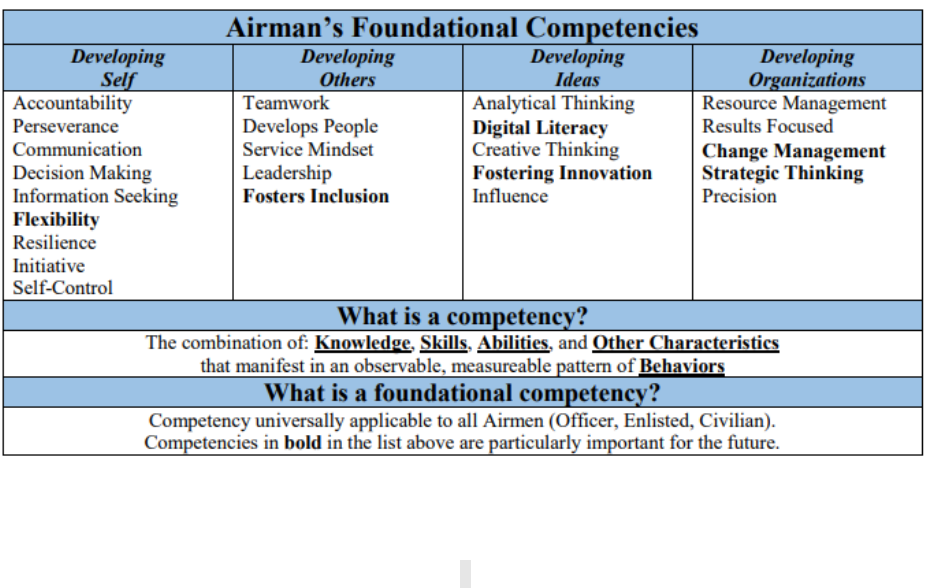
9
counsel. Organizes and controls facilities, supplies, and equipment to support Education and
Training needs. Forecasts Education and Training requirements, determines validity, and
assesses cost. Participates in STRTs, utilization and training workshops, training planning
teams, and training planning groups.
5. Competencies.
The Air Force defines competencies as an observable, measurable pattern
of knowledge, skills, abilities, behaviors, and other characteristics needed to perform
institutional or occupational functions successfully. The Education and Training community
has rebuilt the entire training platform by using competencies to identify the behaviors that
are needed to be successful on the job. This has been accomplished by identifying and
integrating the 3F2X1, Education and Training, occupational competencies and leveraging
the Air Force’s foundational competencies in a manner that provides all Airmen with
transparent and unbiased pathways towards their own successful development.
5.1. Foundational Competencies. The foundational competencies are a set of accepted and
valued competencies, which enable success across a wide array of DAF missions, roles,
functions, and duties. These competencies are the core of Airmen development and enable
Airmen with tools, pathways, and capabilities to improve their performance in any job, specialty,
or situation. The foundational competencies are grouped into different categories of Developing
Self, Developing Others, Developing Ideas, and Developing Organization. Airmen can go to
MyVector (accessible via AF Portal) to complete a self-assessment, which will have them
evaluate themselves on the 24 Airmen’s foundational competencies or a 360-degree assessment,
where subordinates, peers, and leaders can also provide feedback. The assessment tools will
provide Airmen with immediate feedback on personal strengths and areas for improvement.
Additionally, a personal improvement plan with targeted resources (videos, reading content,
developmental opportunities) are provided for continued self-development.
Figure 1. Foundational Competencies.
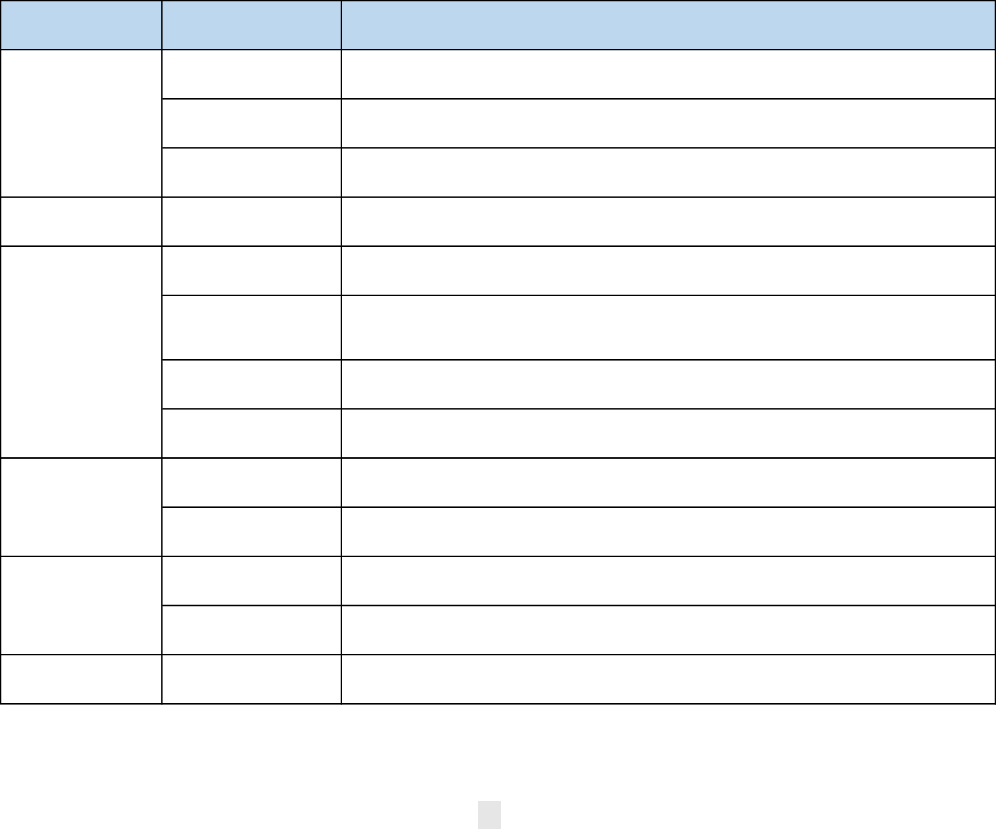
10
5.2. Occupational Competencies. Occupational competencies are a set of competencies
required of all Airmen within a specific workforce category. These competencies provide a
framework that describe the technical/functional skills, knowledge, abilities, behaviors and other
characteristics needed to perform that function’s mission successfully.
5.2.1. Occupational Competency Model. A career field’s competencies can be viewed in a
competency model, which is an organized collection of competencies pertinent to the career
field. The occupational competency model provides a framework to effectively assess, maintain,
and monitor the competencies required for mission success for Airmen within the Education and
Training community. The occupational competency model follows a distinct process with
continued involvement from the career field and allows Airmen to see how their task lists, OJT,
formal courses, and other training, education, and experiences are aligned to the career field’s
strategic objectives.
5.2.2. Career fields work with trained competency experts to identify and develop their
competency model, which consists of the competencies, sub-competencies, and definitions.
Occupational competency models will be different for each career field. The model focuses on
integrating not just the technical components, but also leadership, management, combat, joint,
all-domain, and social mastery competencies required for Airmen to succeed in their career field.
Figure 2 provides an example of a competency model for the 3F2X1 career field.
Competency Sub-Competency Description
Personnel Management
The development and enhancement of an individual's capability in support of the assigned organization's
mission.
Coaching Guiding others to achieve specific personal or professional goals by maximizing an individual's potential.
Resource Management
Identifying and acquiring personnel, equipment, tools, funds, assets, supplies, facilities etc. to achieve an
objective.
Communication Communication
Presenting clear, concise, and meticulous verbal and written information through active listening and
clear messaging, to achieve mission goals, improve processes, and eliminate errors.
Program Management Managing programs mapped to mission priorities or objectives that improve organizational performance.
Upgrade and Qualification
Training Management
Focused execution of an individual's career progression in their skills, knowledge, abilities, and other
characteristics manifested in behaviors to accomplish the mission within their specific functional
community.
Course Management
Deliberate administration of formal and informal programs to comply with the needs and standards of the
individual's continuum of learning.
Testing Management Enforcing academic integrity by executing testing processes.
Curriculum Management Designing and implementing instructional materials that meet mission objectives.
Instruction
Delivering prescribed curriculum designed to develop an individual's skills, knowledge, abilities, and other
characteristics manifested in behaviors.
Data Analytics Discovering, interpreting, and communicating significant trends.
Assessments and
Inspections
Providing objective and impartial appraisal regarding the condition of a program to continuously improve
mission readiness.
Education Services Education Services Assisting and advising on educational opportunities and professional development programs.
Program Effectiveness
Organizational
Management
Instructional Systems
Design (ISD)
Training Management
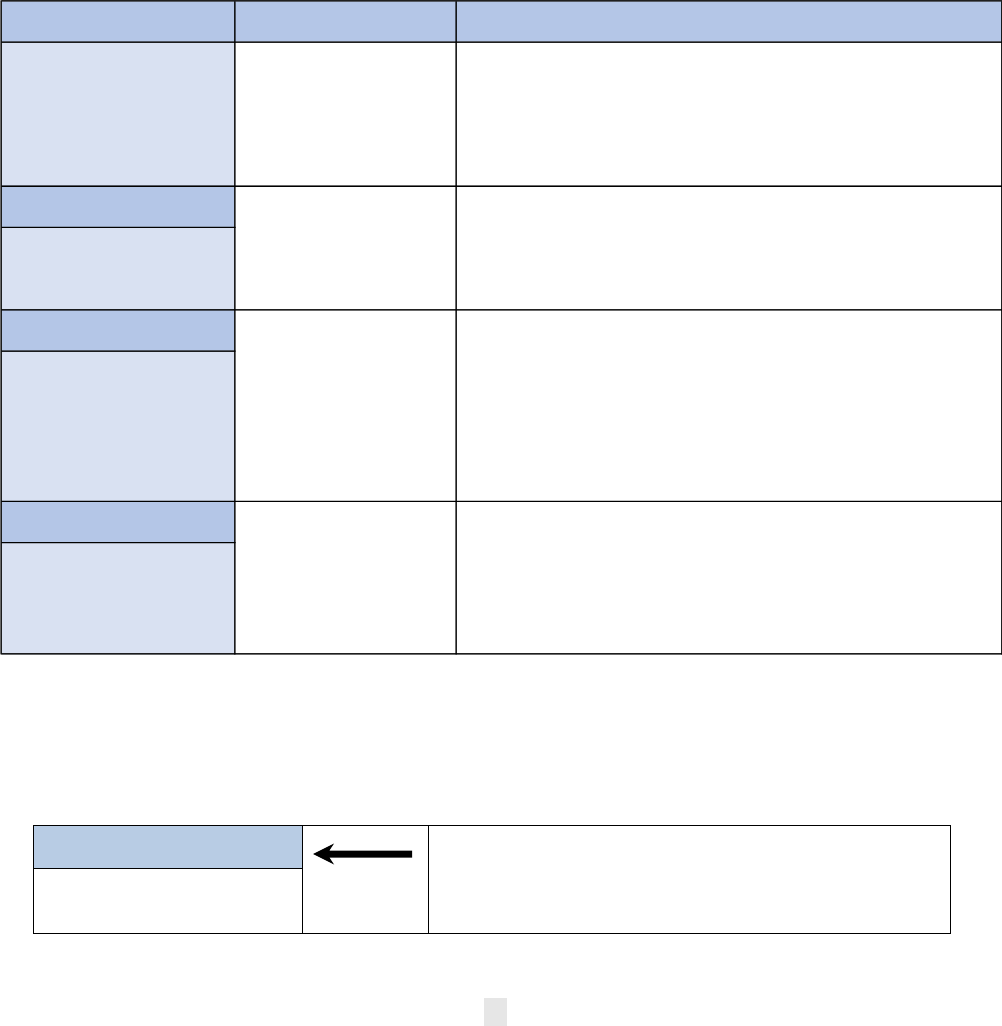
11
Figure 2. 3F2X1, Education and Training, Occupational Competency Model.
5.2.3. Occupational Competency Rubric. After a model is developed, a team of subject matter
experts begin building competency rubrics, which consists of the competency, a description of
the competency, proficiency levels, and measurable and observable behaviors. The competency
rubrics will help Airmen learn which behaviors are aligned to the career field’s strategic
direction, the professional developmental expectations, and the criteria for success. Figure 3
provides an example of a competency rubric for 3F2X1 career field.
Figure 3. 3F2X1, Education and Training, Occupational Competency Rubric for Outbound
Operations.
5.2.4. To better understand how to read and utilize the competency rubric, a breakdown of each
component is explained below in figure 4a-c.
Figure 4a. Competency Rubric Section 1.
Competency
The competency section states the competency group.
Training Management
Supporting Competencies
Basic
Consistency of Application:
Sustained application of
competency over time
- Conducts interviews to identify training needs to meet training requirements
- Tracks training requirements for assigned personnel to ensure qualifications are met
- Manages and updates applicable training systems to ensure information accuracy
- Reports training data to enable senior leaders to make informed decision and provide
corrective actions
Develops People
Organizational Awareness
Accountability
Information Seeking
Sub-Competency
Advanced
Consistency of Application:
Sustained application of
competency over time in complex
situations
- Forecasts education and training requirements to determine validity and attainability
- Interprets and communicates strategic vision and training guidance to enable customers
in meeting requirements
Upgrade and Qualification Training
Management
Description
Intermediate
Consistency of Application:
Sustained application of
competency over time in variety of
situations
- Assess work center priorities to help create accurate training plans
- Advises and assists assigned personnel in completing their responsibilities to meet
training requirements
- Coordinates training for assigned personnel and collaborates with training providers to
support mission readiness
Focused execution of an individual's
career progression in their skills,
knowledge, abilities, and other
characteristics manifested in
behaviors to accomplish the mission
within their specific functional
community.
Observable Behaviors
Training Management
Expert
Consistency of Application:
Able to innovate and formulate
strategies; able to
model/guide/teach other the
competency of how to apply the
competency
- Develops and updates training policies and procedures to improve training effectiveness
- Consults with stakeholders to develop innovative solutions to enhance the organization’s
training program
Competency
Proficiency Levels
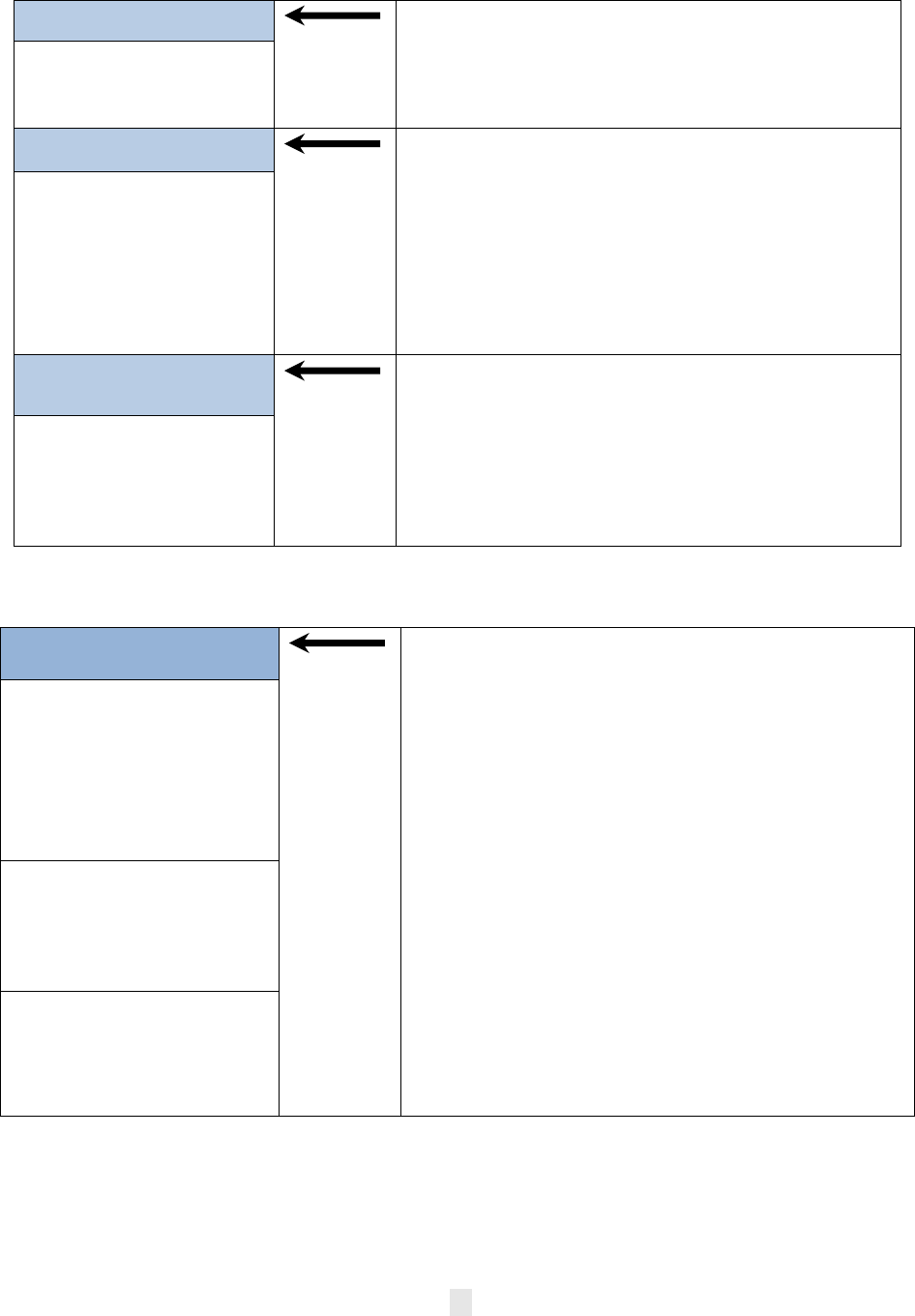
12
Sub-Competency
The sub-competency section states the narrower category that
forms part of the competency group.
Note: Some models may only consist of a competency and
not include a sub-competency.
Upgrade and Qualification
Training Management
Description
The description section provides a statement that gives details
about the sub-competency, enabling career field members to
better understand how sub-competency relates to the AFS.
Focused execution of an
individual's career progression
in their skills, knowledge,
abilities, and other
characteristics manifested in
behaviors to accomplish the
mission within their specific
functional community.
Supporting Competencies
The supporting competencies section are supported-level
competencies that are linked to the success of the sub-
competency. These competencies lend themselves more
toward areas like values, traits, and attitudes. These
competencies were included as part of a larger survey that
went out to the entire AFS; respondents were asked to rate the
top supporting competencies they believe will attribute to
higher successful performance within the sub-competency.
Develops People
Organizational Awareness
Accountability
Information Seeking
Figure 4b. Competency Rubric Section 2.
Proficiency Levels
The proficiency levels are broken into four parts: basic,
intermediate, advanced, and expert.
Under each proficiency level are predetermined criteria selected
by a group of SMEs from your career field and validated by the
career field. The criteria were used as the basis to develop the
observable behaviors. These criteria provide concrete
parameters for the behaviors, which are consistent but
progressive in nature as a member moves up the scale from basic
to expert.
Some of the criteria (e.g., depth of knowledge, consistency of
application/complexity, and thinking challenge) allows an
individual to become an expert through the experience gained in
a particular job and over a period of time. For example, the
person can quickly move up different proficiency levels while
they are serving as a technician at a flight; they move quickly
because they are exposed to a variety of situations.
While other criteria (e.g., scope, impact, and reach of
influence) requires more of a hierarchical approach to gain the
Expert
Consistency of Application:
Able to innovate and formulate
strategies; able to
model/guide/teach other the
competency of how to apply the
competency
Advanced
Consistency of Application:
Sustained application of
competency over time in
complex situations
Intermediate
Consistency of Application:
Sustained application of
competency over time in variety
of situations
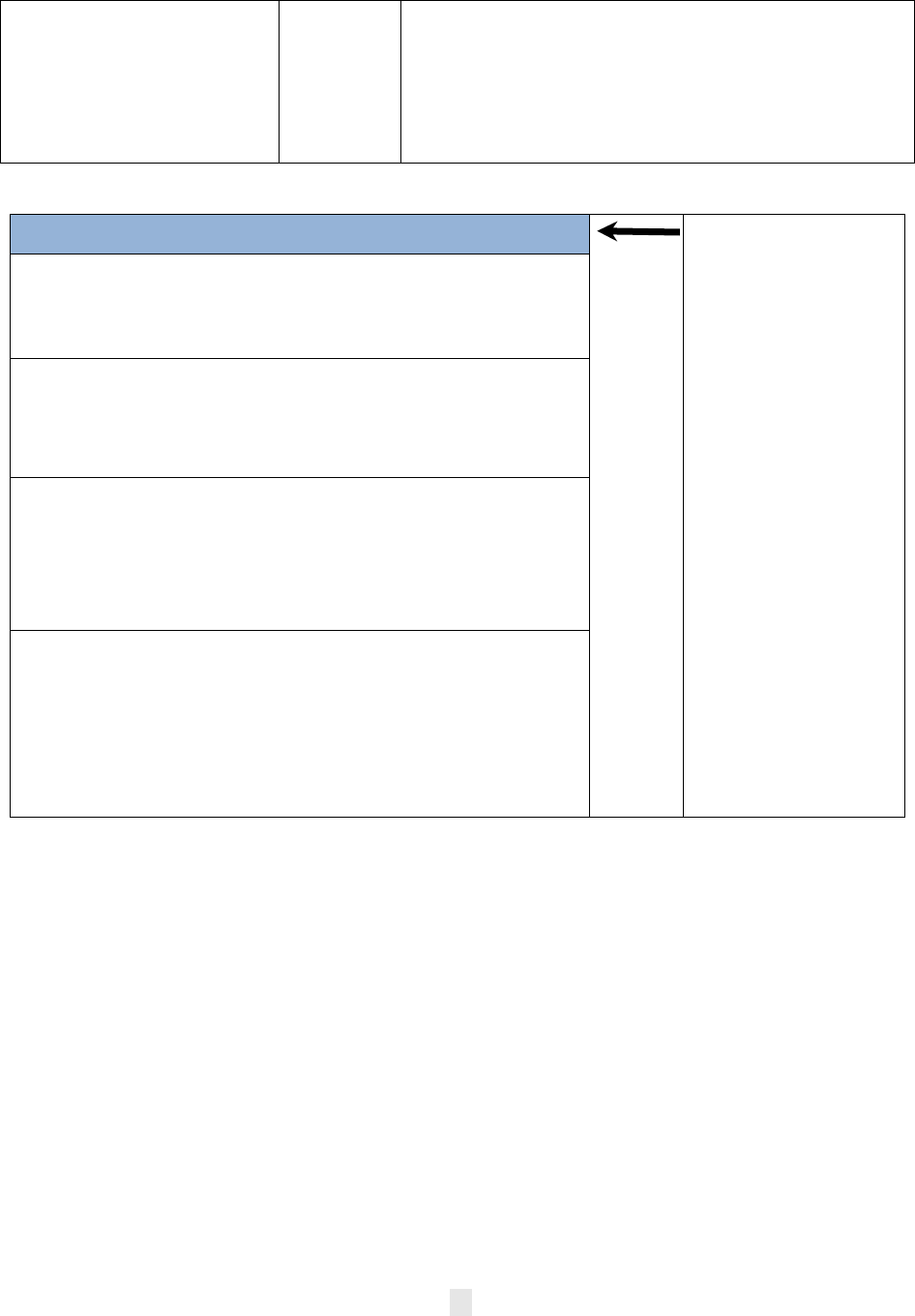
13
Basic
Consistency of Application:
Sustained application of
competency over time
experience needed to progress through the competency levels.
Moving through the proficiency levels may be difficult to do in
certain jobs. For example, if scope at the expert level requires
job integration with the AF-level, then the individual may have
to be in a position where they can gain that experience (i.e., at
HHQ, Wing, or an organization with far reaching capabilities).
Figure 4c. Competency Section 3.
5.2.5 Another key component within the rubric is the supporting competencies section at the
bottom left-hand corner. These are the top four supporting competencies that can help members
excel and be successful in that particular sub-competency. Some of these supporting
competencies are tied directly to the Airmen’s Foundational Competencies, while others may be
unique to the career field. Having these supporting competencies identified and linked to a career
field’s competency model can cultivate those underlying characteristics needed to succeed on the
job. Leaders, supervisors, trainers, instructors, or mentors can now set members up for greater
success by building these supporting competencies and placing their Airmen in situations where
they can apply those strategies. All these elements come together to ensure we can develop
Airmen who are better prepared, present, future mission-focused, and ready to succeed in any
situation. Additionally, AFH 36-2643, Air Force Mentoring Program, has information on how
competencies can be used when an established mentoring strategy is put into effect to foster and
develop Airmen.
Observable Behaviors
The observable behaviors
are statements of what
can be observed from an
individual manifesting
the competency at the
respective competency
level.
They provide objective
evidence that the
individual possesses the
competency level and
shows what effective
performance looks like.
The behaviors are written
to be specific enough so
they can be observable
and lend themselves
towards measurement.
– Develops and updates training policies and procedures to improve
training effectiveness
– Consults with stakeholders to develop innovative solutions to
enhance the organization’s training program
– Forecasts education and training requirements to determine validity
and attainability
– Interprets and communicates strategic vision and training guidance to
enable customers in meeting requirements
– Assesses work center priorities to help create accurate training plans
– Advises and assists assigned personnel in completing their
responsibilities to meet training requirements
– Coordinates training for assigned personnel and collaborates with
training providers to support mission readiness
– Conducts interviews to identify training needs to meet training
requirements
– Tracks training requirements for assigned personnel to ensure
qualifications are met
– Manages and updates applicable training systems to ensure
information accuracy
– Reports training data to enable senior leaders to make informed
decision and provide corrective actions

14
5.2.6. Competency Development. The intent of moving towards a competency-based system is to
sharpen our Airmen’s tactical expertise, operational competence, strategic vision, and joint
proficiency to lead and execute the full spectrum of USAF missions. This occurs not in a
classroom but on the job by combining education, training, and experiences to provide Airmen
with a better developmental pathway as they move along their careers. Airmen are still required
to complete specific training courses, core tasks, and other training requirements in order to
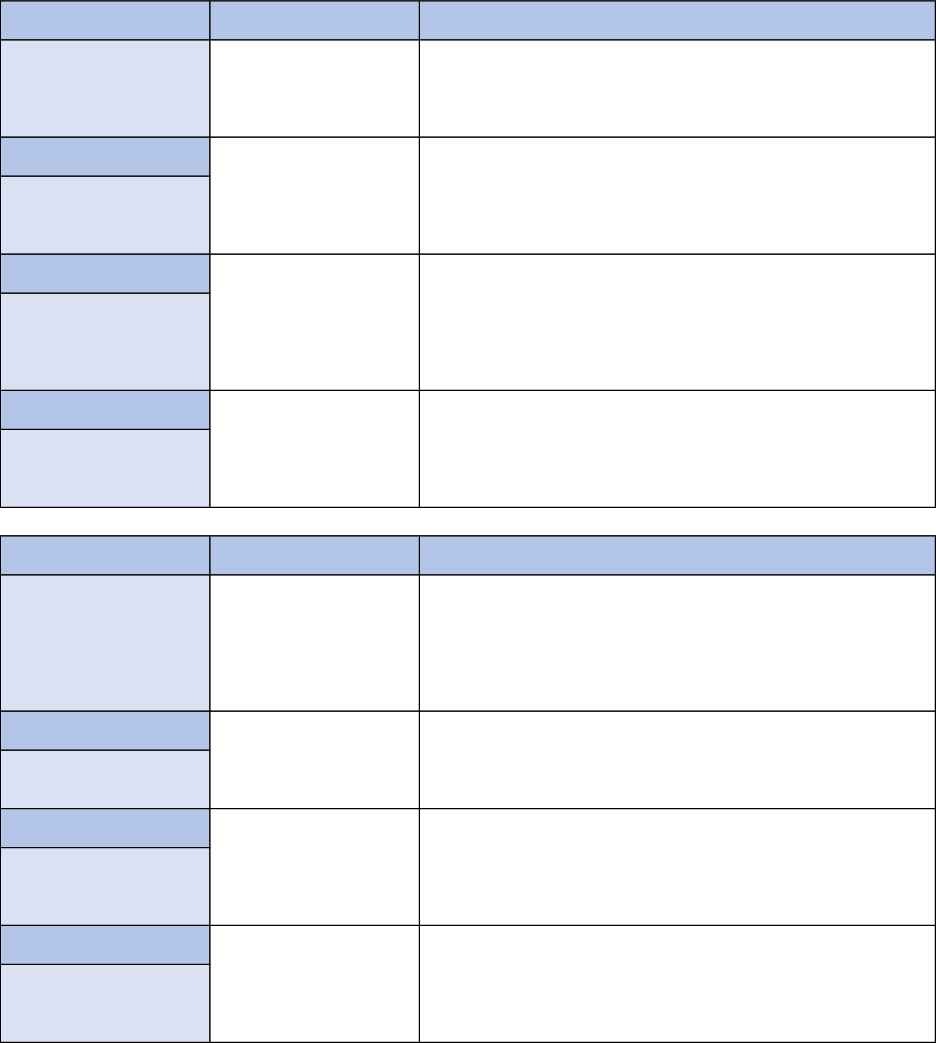
15
attain a 3-, 5-, and 7-skill levels. Competency development allows Airmen to move beyond the
minimum career field requirements and begin addressing developmental gaps and strengthening
their capabilities. The competency model provides information that enables Education and
Training community members to assess their professional growth and development by
comparing their strengths and weaknesses to the clear and objective behaviors outlined in the
model.
5.2.7. Below are the competency rubrics for the 3F2X1, Education and Training, career field.
Personnel Management
Competency
Proficiency Levels
Observable Behaviors
Organizational Management
Sub-Competency
- Vectors personnel for career broadening opportunities and assignments to support
mission requirements and personnel development
- Develops human capital strategies for support of mission priorities
Expert
Reach of Influence:
MAJCOM/AF-Level/Industry
Advanced
Reach of Influence:
Wing/Institutional
- Identifies and capitalizes on opportunities for members to participate in experiential
learning to foster multi-capable Amn strategies
- Encourages collaboration by fostering a team environment to generate new ideas for
programs and process improvement
- Employs personnel to meet mission training requirements
- Leads personnel within a section and provide feedback, internal training, and
development opportunity for subordinates
- Manages and advocates for readiness of personnel to meet local in-garrison and UTC
requirements
Intermediate
Reach of Influence:
Unit/ Groups
- Makes decisions at lowest level and elevates issues through appropriate chain of
command
- Maintains individual accountability and encourages peer accountability to successfully
execute duties, instructions, and responsibilities
- Provides first line support for customer inquires in support of unit, training mission, and
CC priorities
Basic
Reach of Influence:
Individuals
Description
The development and enhancement
of an individual's capability in
support of the assigned
organization's mission.
Supporting Competencies
Accountability
Develops People
Relationship Building
Decision Making
Coaching
- Adjusts coaching techniques to meet delivery challenges by offering alternatives and
back up plans
Competency
Proficiency Levels
Observable Behaviors
Organizational Management
Sub-Competency
- Adopts and customizes new concepts, delivery, and approaches to create effective and
versatile coaches
Expert
Consistency of Application:
Able to innovate and formulate
strategies: able to
model/guide/teach others the
competency of how to apply the
competency
Advanced
Consistency of Application:
Sustained application of
competency over time in complex
situations
Basic
Consistency of Application:
Sustained application of
competency overtime
- Utilizes questioning techniques and guides individuals to create personalized goals
- Builds interpersonal skills with the focus on the development of emotional and social
intelligence
- Assesses progress and offers observational feedback to personalize goal paths to each
individual
- Actively listens, delivers feedback, and provides resources for an individual's
development
- Identifies self-limitations and proactively seeks assistance to aid individuals in complex
situations
Description
Guiding others to achieve specific
personal or professional goals by
maintaining an individual's potential
Supporting Competencies
Communication
Develops People
Analytical Thinking
Flexibility
Intermediate
Consistency of Application:
Sustained application of
competency over time in a variety
of situations

16
Competency
Proficiency Levels
Observable Behaviors
Organizational Management
Expert
Impact on:
AF-level practices/within industry
- Manages career field manning to balance fiscal constraints against mission demands
- Coordinates manpower studies to determine proper authorizations, assignments,
priorities, and projections
- Guides and advocates innovation efforts to streamline and improve training resources
(e.g., training systems, equipment, manpower) to enhance objectives and program
management
Supporting Competencies
Basic
Impact on:
Specific workplace tasks
- Identifies specific materials, equipment, personnel, funding, etc. needed to achieve an
objective
- Secures equipment, materials, and funding to accomplish program objectives
Communication
Organizational Awareness
Decision Making
Strategic Thinking
Sub-Competency
Advanced
Impact on:
Management decisions
- Forecasts changes to manpower, budget, equipment, etc. and advocates for resources
to accomplish the objectives
- Collaborates with multi-level leaders to resolve resource changes and shortfalls in order
to meet the organizations program objectives
- Identifies and resolves manpower, materials, and funding shortfalls
Resource Management
Description
Intermediate
Impact on:
Specific workplace projects
- Coordinates with appropriate agencies to obtain resources for specific project or
program
- Prepares documents and provides justification to support procurement of resources in
order to meet program requirements
- Elevates resource deficiencies when mission capabilities will be impacted
- Establishes procedures and enforces compliance for applicable agencies to utilize
assigned resources
Identifying and acquiring personnel,
equipment, tools, funds, assets,
supplies, facilities etc. to achieve an
objective.
Supporting Competencies
Basic
Consistency of Application:
Sustained application of
competency overtime
- Employs communication methods and tools (e.g., written, verbal, and electronic formats)
to effectively manage unit programs
- Presents clear, accurate, error free communication in support of the customer
- Informs stakeholders on program status and overall health to ensure mission
effectiveness
Relationship Building
Accountability
Precision
Flexibility
Sub-Competency
Advanced
Consistency of Application:
Sustained application of
competency over time in complex
situations
- Initiates cross-organizational communication to synchronize actions and behaviors to
achieve a cohesive objective
- Interprets highly technical subjects or ambiguous information from multiple sources to
affect program changes or improvements
- Identifies and employs new methods of communication to effectively transfer
information throughout organizations
N/A
Description
Intermediate
Consistency of Application:
Sustained application of
competency over time in a variety
of situations
- Collaborates with personnel and shares information to keep stakeholders and customers
actively engaged
- Tailors communication techniques to address identified concerns or desires to various or
diverse audiences to ensure message is received in a non-hostile manner
- Utilizes all five types of communication (e.g., written, visual, verbal, non-verbal, and
active listening) to provide integrated ideas, direction or support across an organization in
order to meet mission priorities
Presenting clear, concise, and
meticulous verbal and written
information through active listening
and clear messaging, to achieve
mission goals, improve processes,
and eliminate errors.
Competency
Proficiency Levels
Observable Behaviors
Communication
Expert
Consistency of Application:
Able to innovate and formulate
strategies: able to
model/guide/teach others the
competency of how to apply the
competency
- Develops and delivers complex information to translate strategic intent into operational
guidance to meet organizational priorities
- Guides personnel on utilization of various communication methods and tools in order to
deliver desired message

17
Competency
Proficiency Levels
Observable Behaviors
Training Management
Expert
Impact on:
Air Force level practices/within
industry
- Solves program limitations and directs revisions for enterprise-wide success
- Advises and coordinates with policy managers outside the functional community to
advocate for program implementation across the enterprise
Supporting Competencies
Basic
Impact on:
Specific workplace tasks
- Articulates procedures and standards on applicable programs to inform leaders on
program status
- Applies project management techniques to execute program requirements to assist
personnel
- Safeguards information to ensure data integrity and personnel privacy
Organizational Awareness
Accountability
Information Seeking
Decision Making
Sub-Competency
Advanced
Impact on:
Management decisions
- Partners with higher-level leadership to provide recommended courses of actions and
enhancements
- Solves program challenges to achieve mission priorities
Program Management
Description
Intermediate
Impact on:
Specific workplace projects
- Utilizes time management to effectively oversee a multitude of programs for
organizational mission accomplishment
- Integrates routine operations while adapting to program revisions for seamless execution
of requirements in support of customers
Managing programs mapped to
mission priorities or objectives that
improve organizational
performance.
Supporting Competencies
Basic
Consistency of Application:
Sustained application of
competency over time
- Conducts interviews to identify training needs to meet training requirements
- Tracks training requirements for assigned personnel to ensure qualifications are met
- Manages and updates applicable training systems to ensure information accuracy
- Reports training data to enable senior leaders to make informed decision and provide
corrective actions
Develops People
Organizational Awareness
Accountability
Information Seeking
Sub-Competency
Advanced
Consistency of Application:
Sustained application of
competency over time in complex
situations
- Forecasts education and training requirements to determine validity and attainability
- Interprets and communicates strategic vision and training guidance to enable customers
in meeting requirements
Upgrade and Qualification Training
Management
Description
Intermediate
Consistency of Application:
Sustained application of
competency over time in variety of
situations
- Assess work center priorities to help create accurate training plans
- Advises and assists assigned personnel in completing their responsibilities to meet
training requirements
- Coordinates training for assigned personnel and collaborates with training providers to
support mission readiness
Focused execution of an individual's
career progression in their skills,
knowledge, abilities, and other
characteristics manifested in
behaviors to accomplish the mission
within their specific functional
community.
Observable Behaviors
Training Management
Expert
Consistency of Application:
Able to innovate and formulate
strategies; able to
model/guide/teach other the
competency of how to apply the
competency
- Develops and updates training policies and procedures to improve training effectiveness
- Consults with stakeholders to develop innovative solutions to enhance the organization’s
training program
Competency
Proficiency Levels

18
Supporting Competencies
Basic
Impact on:
Specific workplace tasks
- Identifies course needs for assigned personnel for continued advancement
- Communicates with key stakeholders and validates training requests for upgrade and
qualification needs
- Schedules training events based on identified requirements for progression in the
continuum of learning
Information Seeking
Organizational Awareness
Initiative
Flexibility
Sub-Competency
Advanced
Impact on:
Management decisions
- Develops guidelines and directives for course management utilization and publishes
guidance through various platforms
- Implement prerequisites parameters and determines equitable allocations of demands
Course Management
Description
Intermediate
Impact on:
Specific workplace projects
- Consolidates course requests to build class schedules and commits resource allocations
to meet training demands
- Disseminates schedules and course information to maximize course utilization
- Collaborates with outside agencies to obtain allocations and budget management to meet
training demands
Deliberate administration of formal
and informal programs to comply
with the needs and standards of the
individual's continuum of learning.
Competency
Proficiency Levels
Observable Behaviors
Training Management
Expert
Impact on:
Air Force level practices/within
industry
- Generates needs assessment for new training demands
- Advocates for new course requirements and resources specified for developmental
needs in the career field
- Implements course validation policy for target audience
Competency
Proficiency Levels
Observable Behaviors
Training Management
- Builds relationships with neighboring testing centers to maintain alternative options
- Develop and implement test management guidance to maintain academic integrity
Expert
Impact on:
AF-level practices/within industry
Enforcing academic integrity by
executing testing processes
Supporting Competencies
Accountability
Precision
Digital Literacy
Results Focused
Testing Management
Sub-Competency
Description
- Analyzes reliability and accuracy of tests to provide recommendations to senior
leadership
- Identifies improvements and implements schedule and procedure revisions to
accommodate mission demands
- Executes necessary actions to support test compromise procedures
Advanced
Impact on:
Management decisions
Intermediate
Impact on:
Specific Workplace Projects
- Maintains current test facility validation to ensure test security, integrity, and inventory
- Standardizes the process for test preparation, facilitation, and uploading completion for
education advancement
- Executes testing procedures to enable testing facility process
- Directs customers to appropriate and pertinent study material and resources to ensure
preparedness
Basic
Impact on:
Specific Workplace Tasks

19
Curriculum Management
- Creates and influences processes that aligns mission, policy, and organizational values
for instructional design
- Teaches personnel on strategies of the instructional system process
- Integrates emerging and advanced learning theories to make necessary adjustments to
the development and design process
Expert
Consistency of Application:
Able to innovate and formulate
strategies; able to
model/guide/teach others the
competency of how to apply the
competency
- Analyzes data and makes recommendations to improve validity, effectiveness, and
efficiency of instructional systems
- Provides guidance and support to stakeholders and SMEs during the instructional
development process
- Evaluates course outcomes for fulfillment of operational objectives
Advanced
Consistency of Application:
Sustained application of
competency over time in complex
situations
Competency
Proficiency Levels
Observable Behaviors
Instructional System
Design (ISD)
Sub-Competency
Description
Designing and implementing
instructional materials that meet
mission objectives.
Supporting Competencies
Creative Thinking
Analytical Thinking
Strategic Thinking
Results Focused
- Conducts task and learning analysis to identify requirements
- Applies the steps of the instructional design process to build training materials in a
variety of delivery platforms
- Compiles data to make necessary adjustments to the instructional system
- Develops assessment tools to identify and measure occupational requirements
Intermediate
Consistency of Application:
Sustained application of
competency over time in a variety
of situations
Basic
Consistency of Application:
Sustained application of
competency over time
- Coordinates with stakeholders and subject matter experts to identify desired learning
outcomes
- Identifies training strategies aligning with learning outcomes to meet objectives
- Integrates existing training materials into the design process to preserve resources
Instruction
- Researches and implements new instructional techniques and technologies for delivery
- Establishes adaptable and personalized learning environments dependent on real-time
data, direct observation, and interaction with personnel
Advanced
Consistency of Application:
Sustained application of
competency over time in complex
situations
- Creates a supportive and challenging learning environment promoting professionalism,
reflective practice, self-directed learning, self-assessment, and lifelong learning
- Trains personnel and provides feedback on proper techniques to enhance instruction
Expert
Consistency of Application:
Able to innovate and formulate
strategies; able to
model/guide/teach others the
competency of how to apply the
competency
Competency
Proficiency Levels
Observable Behaviors
Instructional System
Design (ISD)
Sub-Competency
Communication
Develops People
Flexibility
Relationship Building
Basic
Consistency of Application:
Sustained application of
competency over time
- Demonstrates instructional preparedness in the training environment
- Applies instructional methods and strategies to keep students engaged, on-task, and on-
schedule
- Administers appropriate measurement device to assess student learning
- Promotes inclusion and creates a safe learning environment for all individuals
- Employs multiple strategies that address differing learning styles (e.g., visual, oral,
verbal, social, logical, spatial) of personnel
- Modifies training strategies and instructional techniques based on student feedback
and/or limitations
- Identifies course deficiencies and provides feedback on curriculum content
Intermediate
Consistency of Application:
Sustained application of
competency over time in a variety
of situations
Description
Delivering prescribed curriculum
designed to develop an individual's
skills, knowledge, abilities, and other
characteristics manifested in
behaviors.
Supporting Competencies
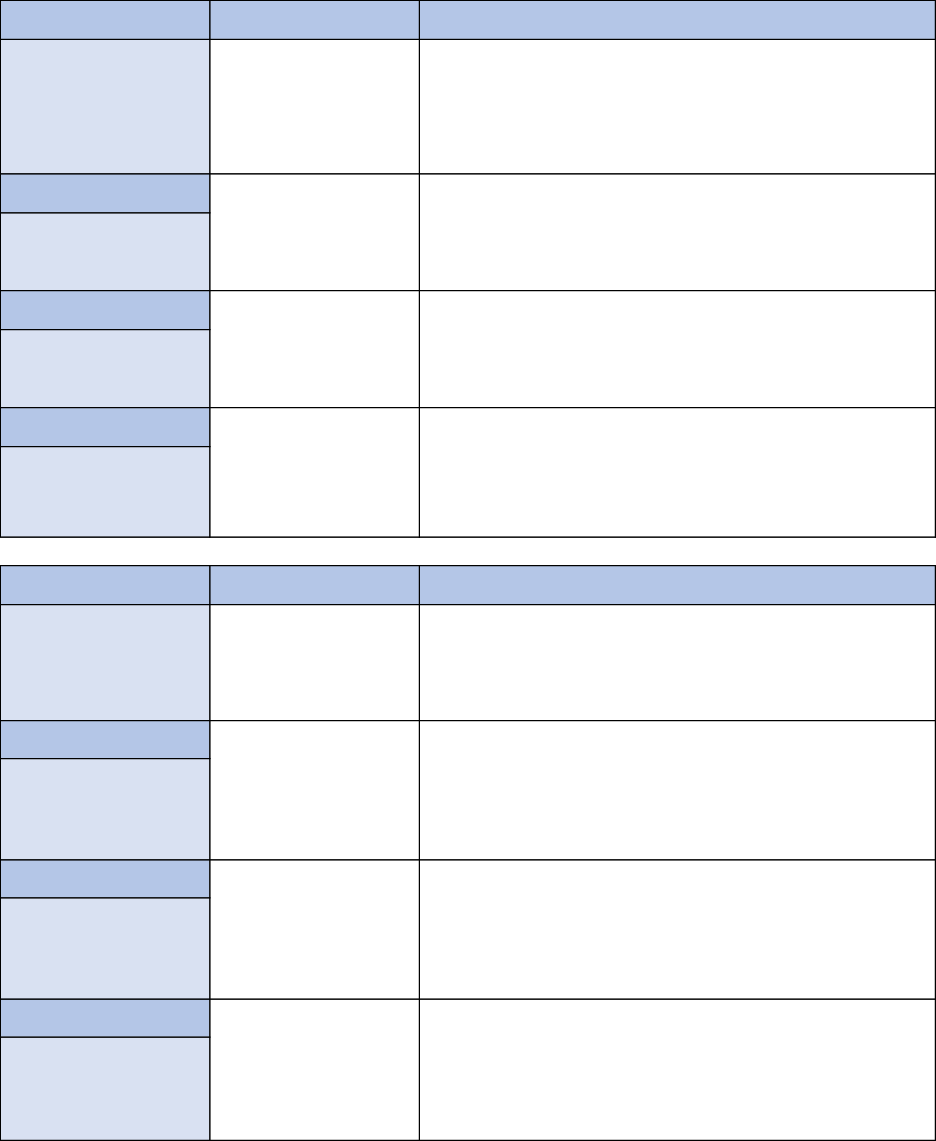
20
Competency
Proficiency Levels
Observable Behaviors
Program Effectiveness
Expert
Scope:
Integration with
AF-level/within industry
- Develops policy for data collection and analysis for achieving statistical objectives
- Analyzes and interprets external guidance for functional community implementation
- Enforces standardized approaches in expectations and gate-keeps other functional
requirements for field implementation
- Designs and regulates information timelines and structures channeling standardized
execution for enterprise-wide operations
Supporting Competencies
Basic
Scope:
Specific Area
- Retrieves data and collects statistical inputs for unit requirements and incorporates data
for further analysis
- Compiles data to illustrate training program effectiveness for key leaders
- Communicates key performance indicators (KPI) for the effective and efficient mission
parameters to unit leaders
- Files and stores empirical data to ensure compliance with program requirements
Analytical Thinking
Information Seeking
Digital Literacy
Organizational Awareness
Sub-Competency
Advanced
Scope:
Integration with
organizational strategies
- Examines statistical data from lower levels to highlight potential training gaps and
determine viable solutions
- Collaborates with functional community and leadership to determine benchmarked
approaches to data provisions for implementation
- Elevates substandard trends and concerns for solution determinations and guidance
Data Analytics
Description
Intermediate
Scope:
Integration with
concerned areas
- Identifies deficiencies and trends to evaluate overall training effectiveness
- Correlates and differentiates implied statistical data to assist leaders to resolve training
deficiencies, issues, and compliance within the unit
Discovering, interpreting, and
communicating significant trends.
Competency
Proficiency Levels
Observable Behaviors
Program Effectiveness
Expert
Scope:
Integration with
AF-level/within industry
- Develops policy for inspections and assessments within functional community
- Creates checklists and criteria used by field to measure training effectiveness
- Responds and develops inspection adjustments and issues between HHQ and unit level
personnel
Supporting Competencies
Basic
Scope:
Specific Areas
- Reviews pertinent information to identify training trends and gaps
- Conducts inspection to evaluate work center
- Briefs stakeholders on inspections findings and provides recommended courses of
action for improvement in mission readiness
- Authors assessment reports and publishes for historical data to maintain training
effectiveness
Accountability
Communication
Information Seeking
Organizational Awareness
Sub-Competency
Advanced
Scope:
Integration with
organizational strategies
- Interprets internal assessments to provide sample plans and direction to IG teams
- Continuously evaluates lower level self-assessment checklists for inclusion in strategic
planning
- Augments face-to-face inspections as directed by command leadership for lower level
validation
- Authors command specific policy and direction to guide inspectors for high interest
items and concerns
Assessments and Inspections
Description
Intermediate
Scope:
Integration with
concerned areas
- Inspects base level programs and presents trend analysis for wing leadership awareness
and decision making
- Re-examines shortfalls in unit training programs and provides assistance to key
personnel to implement recommended improvements
- Composes inspection and assessment reports and elevates findings to leadership for
advancement in training programs
Providing objective and impartial
appraisal regarding the condition of
a program to continuously improve
mission readiness.
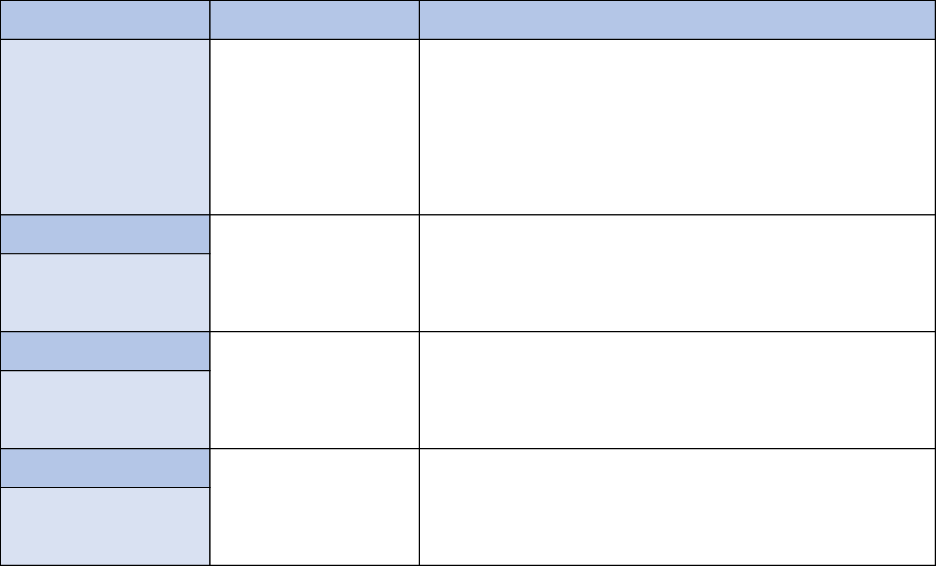
21
6. Training Decisions. The CFETP has undergone a considerable revision towards building a
competency-based training and development platform for the Education and Training career
field. A significant change has been to shift the focus from task-based training to one that is more
centered on outcomes-based learning. A task is a unit of work activity or operation which forms
a significant part of a duty. These are singular in nature and are usually accomplished in one
continuous action, which also can occur independently of other tasks. Conversely, outcomes are
learning goals that typically consist of a multitude of tasks. These outcomes are actions and
performances that embody and reflect the learner’s competence in using content, information,
ideas, and tools successfully. Focusing on learning outcomes allow organizations, leaders,
supervisors, and trainers to incorporate foundational competencies and underlying characteristics
(values, traits, attitudes) into learning, which is necessary for developing Airmen with the
competencies needed for future challenges. The following decisions were made as a result of
close coordination between HQ AETC, 2AF Technical Training, schoolhouse instructors and
staff, field SMEs, functional managers and the AFCFM. The final training requirements are then
approved by the Career Field Manager.
6.1. A planning meeting/STRT was held from 26-30 September 2022 at Keesler AFB, MS.
Members of the planning meeting/STRT sought to develop the learning outcomes. This was
accomplished by reverse engineering the behaviors found in the Education and Training
occupational competency model and then by asking what does an Airman need to know and do
in order to master a specific behavior. The intent of the learning outcomes is to identify all
factors needed to succeed in attaining the behavior. During the planning meeting, members
decided (approved at STRT portion) to remove the qualitative proficiency code key and use a
behavioral statement coding system for the STS.
Competency
Proficiency Levels
Observable Behaviors
Educational Services
Expert
Consistency of Application:
Able to innovate and formulate
strategies; able to
model/guide/teach other the
competency of how to apply the
competency
- Oversees policy and advocates for the education program to provide up to date military
and civilian credentialing, processes and requirements
- Liaises and coordinates with CCAF, associated colleges, and other educational
institutions for completion of educational goals
Supporting Competencies
Basic
Consistency of Application:
Sustained application of
competency over time
- Assists individuals with educational benefits and credentialing opportunities to meet
professional and academic goals
- Updates applicable management systems to ensure records accuracy and educational
life cycle
Communication
Develops People
Service Mindset
Digital Literacy
Sub-Competency
Advanced
Consistency of Application:
Sustained application of
competency over time in complex
situations
- Implements force development programs to ensure personal and professional
requirements are met
- Advises senior leadership on education issues to ensure program integrity and success
Education Services
Description
Intermediate
Consistency of Application:
Sustained application of
competency over time in variety of
situations
- Counsels individuals on educational benefits, programs, and requirements to meet
professional and academic goals
- Advertises and disseminates academic information to familiarize individuals and
communities about educational opportunities
Assisting and advising on
educational opportunities and
professional development
programs.
22
As a result, each line item will consist of a verb and the coding system for formal training will
only use P (performance), K (knowledge), and pk (performance-knowledge).
6.2. The CFETP uses a building block approach (simple to complex) to encompass the entire
spectrum of training requirements for the 3F2X1 career field. The spectrum includes a strategy
for when, where, and how to meet the training requirements. The strategy must be apparent and
affordable to reduce duplication of training and eliminate a disjointed approach to training. The
training decisions were made during the STRT held 26-30 September 2022 and utilizing the ISD
process as implemented by 335TRS/UOB during training planning and course development.
6.3. Skill and Career Progression.
Adequate training and timely progression from the
apprentice to the superintendent level play an
important role in the Air Force’s ability to
accomplish its mission. It is essential that everyone involved in training do their part to plan,
manage, and conduct an effective training program. The guidance provided in this part of the
CFETP will ensure each individual receives viable training at appropriate points in their career.
6.3.1. Apprentice (3) Level.
The initial skills course, E3ALR3F231 01AC Education and
Training Apprentice, must be completed for the award of AFSC 3F231. Initial skills training
requirements were identified during the 3F2X1 STRT.
6.3.2. Journeyman (5) Level.
Qualification in and possession of AFSC 3F231 and completion
of UGT consisting of completing: (1) CDCs (if available); (2) all core tasks identified with “5”;
(3) meet time in training requirements as identified by the AFCFM on myFSS “Time in Training
Requirements”; (4) recommended by supervisor and approved by their commander for the award
of AFSC 3F251.
6.3.3. Craftsman (7) Level.
Qualification in and possession of AFSC 3F251. Begin UGT to
the 7-skill level upon selection to SSgt or DOR for ARC. UGT consists of completing: (1) all
core tasks identified with a number “7”; (2) meet time in training requirements as identified by
the AFCFM on myFSS “Time in Training Requirements”; (3) recommended by supervisor and
approved by their commander for the award of AFSC 3F271. Core tasks identified with “7/R”
are mandatory for RegAF but optional for ANG and AFRC.
6.3.4. Superintendent (9) Level.
Qualification in and possession of AFSC 3F271. Must be at
least a Senior Master Sergeant (SMSgt) and meet mandatory requirements listed in the AFECD,
have completed SNCOA or sister-service equivalent, and be recommended by their supervisor
and approved by their commander for award of the 9-skill level.
6.4. 3-Skill Level Training.
The initial skills course, E3ALR3F231 01AC, has been revised by
335 TRS/UOB at Keesler AFB to provide training needed to prepare graduates for education and
training related positions.
6.5. 5-Skill Level Upgrade Training.
There is no advanced 5-level course at this time.
6.6. 7-Skill Level Advanced Training.
There is no advanced 7-level course at this time.
23
7.
The CFETP Part II identifies thirteen (13) sub-competencies. Each competency is further
broken down into the following proficiency levels: basic, intermediate, advanced, and expert.
The proficiency levels are not tied to a specific rank or position. Additionally, each occupational
competency has supporting competencies tied to them. The supporting competencies allow
Airmen to intentionally develop those transferrable underlying characteristics that will translate
to mission capabilities, mission readiness, and mission success for the agile, future thinking
Airmen. Airmen, supervisors, trainers, mentors, and leaders should look for opportunities to
integrate the supporting competencies into every facet of an Airman’s development as they seek
to gain and increase proficiency within the Education and Training competencies.
8. Community College of the Air Force (CCAF).
Enrollment in CCAF occurs automatically
upon completion of basic military training and assignment to an Air Force career field. CCAF
provides the opportunity to obtain an Associate of Applied Sciences Degree. Exception: AFSC
3F2X1 personnel must request enrollment into the new degree program through their Education
Service Office. In addition to its associate degree program, CCAF offers the following:
8.1. Certifications
8.1.1. CCAF Instructor Certification (CIC) Program
.
This program is for qualified
instructors who teach CCAF collegiate-level credit awarding courses at a CCAF affiliated
school. The CIC is a professional credential that recognizes the instructor's extensive faculty
development training, education and qualification required to teach a CCAF course, and formally
acknowledges the instructor's practical teaching experience. Qualified officer, enlisted, civilian
and other service instructors are eligible for this certification.
8.1.2. CCAF Instructional Systems Development Certification.
CCAF offers the
Instructional Systems Development (ISD) Certification for qualified individuals who develop
CCAF courses/curriculum at CCAF affiliated schools. The purpose of the certification is to
recognize the training and education required for individuals to be qualified to develop and
manage CCAF collegiate courses. The certification also recognizes the individual’s ISD
qualification and experience in planning, developing, implementing, and managing instructional
systems. Qualified officer, enlisted, civilian, and other service curriculum writers/developers are
eligible for this certification.
8.1.3. AF Credentialing Opportunities On-Line (AF COOL).
The AF COOL is a Total
Force Enlisted program. It includes all enlisted AFSCs for RegAF, AFR, ANG, and USSF.
Members of the ARC MUST be on Title 10 or 32 active orders for the duration of the AF COOL
process (FDO: upload member's AD orders in AFAEMS). This program assists Airmen in
navigating through the various civilian credentialing opportunities that are available for their
control/duty AFSCs. AF COOL provides a one-stop-shop for Airmen to explore credentials
recognized by the civilian community that can enhance an Airman's current performance in their
AF specialty as well help prepare for civilian employment. Please review all the tabs as each has
important information for successful completion of an AFSC-related credential.
8.2. Degree Requirements.
Prior to completing an associate degree, the 5-skill level must be
awarded, and the following requirements must be met:
Semester Hours

24
Technical Core/Elective Education
_________________________________________________24
Leadership, Management, and Military Studies_______________________________________
6
General
Education
__________________________________________________________
15
Oral Communication, Written Communication, Mathematics Social Science and
Humanities
Program
Elective
_____________________________________________________________
15
Technical Education; Leadership, Management, and Military Studies; or General
Education
Total________________________________________________________________________ _ 60
8.2.1. Technical Education (24 Semester Hours
):
A minimum of 9 semester hours of
technical core subjects/courses must be applied and the remaining semester hours applied from
Technical Core or Technical Elective subjects and courses. Specific requirements can be found
in the latest CCAF catalog located at
https://www.airuniversity.af.edu/Barnes/CCAF/
.
8.2.2. Leadership, Management, and Military Studies (6 Semester Hours):
Professional
military education and/or civilian management courses.
8.2.3. General Education (15 Semester Hours):
Applicable courses must meet the criteria
for application of courses to the General Education Requirements (GER) and be in agreement
with the definitions of applicable General Education subjects/courses as provided in the CCAF
General Catalog.
8.2.4. Program Elective
(
15 Semester Hours
):
Satisfied with applicable Technical
Education; Leadership, Management, and Military Studies; or General Education subjects and
courses, including natural science courses meeting GER application criteria. Nine semester hours
of CCAF degree applicable technical credit otherwise not applicable to this program may be
applied. See the CCAF General Catalog for details regarding the Associate of Applied Science
degree for this specialty.
8.3. Off-duty Education.
While additional off-duty education is a personal choice and is
encouraged for all, the 3F2X1 AFCFM strongly advocates it for all Education & Training
Managers.
9. Career Field Path.
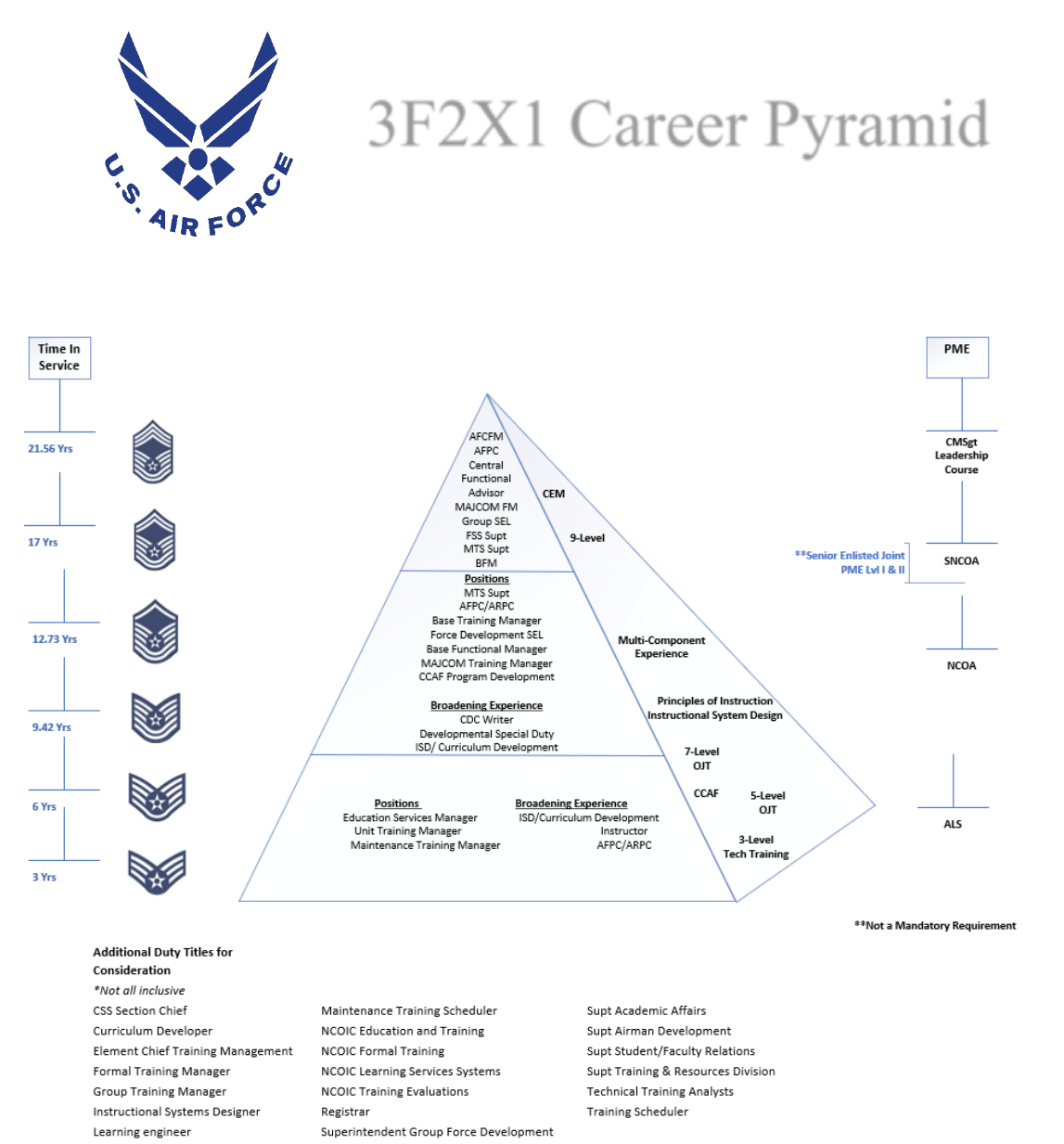
25
9.1. 3F2X1 Career Pyramid
3F2X1 Career Pyramid
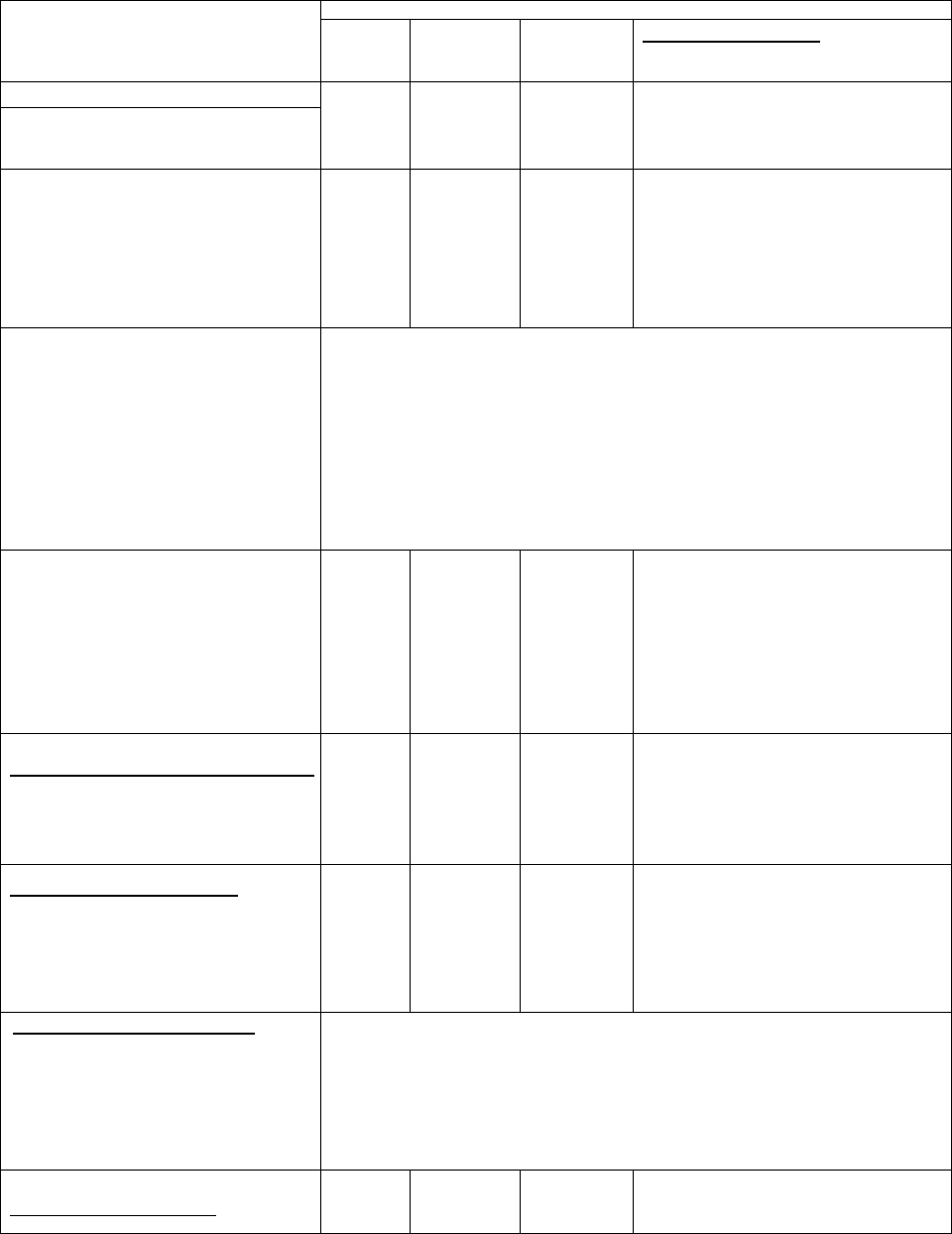
25
9.2.
3F2X1 Enlisted Career Path.
Education and Training
Requirements
GRADE REQUIREMENTS
Rank
Average
Sew-
On
Earliest
Sew-
On
High Year of Tenure
(HYT)
Basic Military Training School
Amn
A1C
6 months
16 months
Apprentice Technical School
(3-Skill Level)
Upgrade to Journeyman
(5-Skill Level)
- Complete core / duty
position requirements
- meet time in training requirements as
identified by the AFCFM
Amn
A1C
SrA
16 months
3 years
28 months
10 years
Airman Leadership School
- Must be a SrA with 36
months’ time in service or a
SSgt Selectee.
- Resident graduation is a
prerequisite for SSgt sew-on
(Active Duty Only)
Trainer
-
Must
attend
the
AF Training
Course
(AFTC)
- Must be qualified to perform the task to be trained
Certifier
- Certifiers must be at least a SSgt (E-5) with a 5-skill level or
civilian equivalent, capable of evaluating the task being certified,
and have completed the AFTC
Upgrade to Craftsman
(7-Skill Level)
- Minimum rank SSgt Select
- Complete core / duty
position requirements
- meet time in training requirements as
identified by the AFCFM
SSgt
6 years
3 years
20 Years
Non-Commissioned Officer Academy
Complete NCOA: Required for
promotion to MSgt
TSgt
MSgt
9.4 years
12.7 years
5 years
8 years
22 years
24 years
Upgrade to Superintendent
(9-Skill Level)
- Minimum rank of SMSgt.
- Mandatory requirements
in AFECD
SMSgt
17 years
11 years
26 years
USAF Senior NCO Academy
Complete SNCOA: Required for
promotion to SMSgt
Chief Enlisted Manager (CEM)
CMSgt
21.5 years
14 years
30 years
26
9.3. Occupational Badges.
9.3.1. Wear the basic badge after completing technical school or completion of 3-level tasks if
technical school is waived. Wear the senior badge after award of the 7-skill level, and the master
badge as a master sergeant or above. For proper wear, follow the guidance in the DAFI 36-2903,
Dress and Personal Appearance of United States Air Force and United States Space Force
Personnel.
Section C - Skill Level Training Requirements
10. Purpose.
Skill level training requirements in this specialty are defined in terms of task and
knowledge requirements. This section outlines the specialty qualification requirements for each
skill level in broad, general terms and establishes the mandatory requirements for entry, award
and retention of each skill level. The specific task and knowledge training requirements are
identified in Part II of this CFETP.
11. Specialty Qualification:
The initial skills course, E3ALR3F231 01AC Education and
Training Apprentice, must be completed for the award of AFSC 3F231. Initial skills training
requirements were identified during the 3F2X1 STRT, held 26-30 September 2022.
11.1. Apprentice Level Training
11.1.1. Specialty Qualification.
11.1.1.1. Knowledge.
Comprehension of: principles, policies, and procedures of Air Force
Education and Training programs; interviewing and counseling techniques; training techniques
and instruction methods; task analysis procedures, learning process, curriculum development,
training evaluations, and Education and Training systems and products; effective writing skills;
editing practices; instructional media application, training reporting, program and curriculum
validation, and implementation procedures; training program management; scheduling training
events and facilities; conducting assistance visits and training meetings; work center and
individual job qualification standard development; education institution registration
requirements; military personnel classification system and policies; application of
communicative interpersonal skills; and distance learning concepts.
11.1.1.2. Education.
Completion of high school is mandatory for entry into this specialty.
Academic courses in English grammar and composition, speech, psychology, guidance, and
sociology are desirable.
11.1.1.3. Training.
Completion of the following is mandatory (unless waived by the AFCFM):
course E3ALR3F231 01AC, Education and Training Apprentice. Completion of the following
courses are desirable: instructor-training course, technical writing course, curriculum
development course, academic counseling course, instructional system designer course, and
principles of instruction course. Completion of the Instructional System Designer course is
mandatory for personnel performing curriculum designer functions. Completion of an accredited
instructor-training course is mandatory for individuals assigned to instructor positions.
27
11.1.1.4. Experience.
N/A
11.1.1.5. Other.
Prior qualifications in any AFSC at the 5-skill level or higher (3-skill level, if
no 5-skill level exists), (SrA or higher) and the ability to speak clearly and distinctly are
mandatory for entry into and retention of this specialty. Ability to use word processing software
is desirable. Must have a mandatory ASVAB Admin score of 62. Retraining interviews are
mandatory for entry into this career field. The AFSC 3F2X1 base functional manager conducts
the interview. For RegAF, retraining applicants must shadow a 3F2 for 5 duty days with a
current 5-7 level 3F2 appointed by the Base Functional Manager. The days a member shadows
do not need to happen consecutively, but all 5 days must be completed before the BFM endorses
the interview/recommendation letter. Note, members who have fulfilled ADUTM additional
duty within the last year are exempt (documented on BFM recommendation letter). Shadowing
topics will include: OJT rosters, TPM briefing, training systems updates, CDCs, workcenter
visits, Microsoft office applications.
11.1.2. Training Sources and Resources.
Successful completion of course E3ALR3F231
01AC, Education and Training Apprentice (PDS Code 472), satisfies the knowledge and training
requirements specified in the specialty qualification section (above) for award of the 3-skill level.
11.2. Journeyman Level Training.
11.2.1. Specialty Qualification: Enter 5-skill level UGT after completion of the 3-skill level
course.
11.2.1.1. Knowledge.
Comprehension of: principles, policies, and procedures of Air Force
Education and Training programs; interviewing and counseling techniques; training techniques
and instruction methods; task analysis procedures, learning process, curriculum development,
training evaluations, and Education and Training systems and products; effective writing skills;
editing practices; instructional media application, training reporting, program and curriculum
validation, and implementation procedures; training program management; scheduling training
events and facilities; conducting staff assistance visits and training meetings; work center and
individual job qualification standard development; education institution registration
requirements; military personnel classification system and policies; application of
communicative interpersonal skills; and distance learning concepts.
11.2.1.2. Education.
N/A
11.2.1.3. Training.
UGT consists of completing all core tasks identified with a “5” in the STS
located in Part II of this CFETP, completion of CDCs (if available), recommended by their
supervisor and approved by their commander for the award of AFSC 3F251. Meet time in
training requirements as identified by the AFCFM on myFSS. Supervisors must ensure task
proficiency and experience levels are met to fulfill upgrade requirements.
11.2.1.4. Experience.
Qualification in and possession of AFSC 3F231. Experience conducting
or developing education or training programs, and qualification in assigned tasks in education
services or unit, base, or maintenance training duty positions (if applicable).
28
11.2.1.5. Other.
Off duty education is highly recommended and encouraged for 3F2s.
MyVector, Percipio, and Digital University have many courses available to further develop your
skills and competencies at no cost. These courses can be utilized for career broadening and
professional growth. Beneficial topics may include:
- Building Trust with Business Ethics
- Critical Thinking
- Developing Emotion Intelligence
- Expert Insights on Managing Stress
- Giving/Receiving Feedback
- Negotiating
- Networking & Building Relationships
11.2.2. Training Sources and Resources.
N/A
11.3. Craftsman Level Training:
11.3.1.
Specialty Qualification.
All 3F231 and 3F251 qualifications apply to 3F271
requirements.
11.3.1.1. Knowledge.
Comprehension of: principles, policies, and procedures of Air Force
Education and Training programs; interviewing and counseling techniques; training techniques
and instruction methods; task analysis procedures, learning process, curriculum development,
training evaluations, and Education and Training systems and products; effective writing skills;
editing practices; instructional media application, training reporting, program and curriculum
validation, and implementation procedures; training program management; scheduling training
events and facilities; conducting assistance visits and training meetings; workcenter and
individual job qualification standard development; education institution registration
requirements; military personnel classification system and policies; application of
communicative interpersonal skills; and distance learning concepts.
11.3.1.2. Education. To assume the grade of SSgt and MSgt, individuals must be graduates of
the Airman Leadership School and NCO Academy, respectively (for ARC, completion of
AFIADL Courses 00001 and 00015 satisfy the ALS & NCO Academy requirement).
11.3.1.3. Training. Completion of the following requirements is mandatory for the award of the
7-skill level: all core tasks (identified with a number “7”), recommended by their supervisor and
approved by their commander for the award of AFSC 3F271. Core tasks identified with “7/R” are
mandatory for RegAF but optional for ANG and AFRC. Meet time in training requirements as
identified by the AFCFM on myFSS. Supervisors must ensure task proficiency and maturity
levels are met to fulfill upgrade requirements.
11.3.1.4. Other.
Off duty education is highly recommended and encouraged for 3F2s.
MyVector, Percipio, and Digital University have many courses available to further develop your
skills and competencies at no cost. These courses can be utilized for career broadening and
professional growth. Beneficial topics may include:
29
- Business Plan Development
- Inclusive Leadership: Working w/ Equality & Diversity
- Sharing a Vision
- Strategic Planning & Execution
- Strategic Thinking
- Talent Development and Transformation
11.3.2. Training Sources and Resources. Completion of training references listed in the CFETP
Part II satisfies the knowledge requirements specified in the specialty qualification section for
award of the 7-skill level. The CFETP Part II identifies all the core tasks required for
qualification.
11.4. Superintendent Level Training:
11.4.1. Specialty
Qualification.
11.4.1.1. Knowledge.
Comprehension and application of: education, maintenance and support
training management, functions, and policies; related military personnel classification policies;
instructional system development, management, operation, and evaluation; wartime and
contingency training planning; and test development, administration, and management.
11.4.1.2. Education.
To assume the grade of SSgt, MSgt, and SMSgt individuals must be
graduates of the Airman Leadership School, NCO Academy, and SNCO Academy respectively.
11.4.1.3. Training.
Qualification as an Education and Training Craftsman, recommended by
supervisor and approval by their commander is mandatory for the award of AFSC 3F291.
11.4.1.4. Experience. Must be at least a SMSgt, meet mandatory requirements listed in the
AFECD, recommended by supervisor and approved by commander, and experience in directing
functions such as education and training programs.
11.4.1.5. Other. N/A
11.4.2. Training Sources and Resources.
N/A
Section D - Resource Constraints
12. Purpose. This section identifies known resource constraints that preclude optimal and
desired training from being developed or conducted, including information such as cost and
manpower. Resource constraints will be, at a minimum, reviewed and updated annually.
30
13. Apprentice Level Training:
E3ALR3F231 01AC, Education and Training Apprentice
Course.
13.1. Constraints. Required lead-time for development of resident training to meet added and
changed training requirements specified in this CFETP.
13.1.1. Impact. Training to support this CFETP will be implemented with the class beginning
1 Oct 23.
13.1.2. Resources Required. Manpower resources are available to complete required course
revisions by the specified target completion date. Command assistance may be necessary to
supplement job experience and subject matter expertise of the assigned instructor staff.
13.1.3. Action Required.
Complete a revision of the 3-level course to meet all training
requirements and
behavioral statement coding
identified in this CFETP.
13.2. OPR/Target Completion Date. 335TRS/UOB will implement revised training with the
class beginning 1 Oct 23.
14. Journeyman Training: CDC 3F251, Education and Training Manager Journeyman
ACTIVATED.
14.1. Constraints.
Supervisors and trainers will meet added and changed training
requirements specified in this CFETP via On-the-Job training.
14.1.1. Impact.
N/A
14.1.2. Resources Required. Manpower resources are available to complete required course
revisions by the specified target completion date. Command assistance may be necessary to
supplement job experience and subject matter expertise of the assigned instructor staff.
14.1.3. Action Required. On-the Job training conducted by supervisors and/or trainers to meet all
training requirements identified in this CFETP.
14.2. OPR/Target Completion Date. 335TRS/UOB will revise methodology and medium of
new formal course, Education and Training Manager Journeyman.
15. Craftsman
Training: N/A
31
Part II
Section A – Specialty Training Standard (STS)
1. Implementation. The STS will be used for technical training provided by AETC for the
3-skill level Education and Training Apprentice.
2. Purpose.
As prescribed in DAFMAN 36-2689, this STS:
2.1.
Is used to document task completion when placed in the AF Form 623, Individual
Training Record, and used according to DAFMAN 36-2689. CFETP documentation shall be
IAW DAFMAN 36-2689 or any subsequent messages.
2.2. Attachment 1. Qualitative Requirements
. Contains the
behavioral statement
coding
used to indicate the level of training and knowledge provided by resident training and career
development courses.
2.3.
Lists in column 1 the most common competencies/learning outcomes, knowledge, and
Technical References (TR) necessary for Airmen to perform their duties in the 3-, 5-, and 7-
skill level.
2.4.
Column 2 lists the “behavior match” as outlined in the competency header for required
behaviors.
2.5.
Identifies, in column 3 column, core tasks by the number of skill level it is required for
(“5”, “7” or “9”) and column 4 deployment tasks by a diamond, (*), TQT tasks by a ♦. Core
tasks identified with “7/R” are optional for ANG and AFRC. Base level 3F2 functional
manager will schedule training for personnel tasked to fill a deployed training position with
the base education office."
2.6.
Provides certification for OJT. Columns 5-9 are used to record completion of tasks and
knowledge training requirements. Use automated training management systems to document
technician qualifications, if available.
2.7.
Shows formal training and correspondence course requirements. Columns 10-13 shows
the proficiency to be demonstrated on the job by the graduate as a result of training on the
task and the career knowledge provided by the corresponding course.
2.8.
Is a guide for development of promotion tests used in the Weighted Airman Promotion
System (WAPS). SNCOs with extensive practical experience in their career fields develop
the Specialty Knowledge Tests (SKTs) at the AETC SAS/OA. The tests sample knowledge
of STS subject matter areas judged by test development team members as most appropriate
for promotion to higher grades. Questions are based upon study references listed in the
Enlisted Promotion References and Requirements Catalog (EPRRC). Individual
responsibilities are in DAFMAN 36-2664, Personnel Assessment Program.

32
3. Third Party Certification.
Core tasks identified in this CFETP do not
require third- party certification.
4. Recommendations. Comments and recommendations are invited concerning the quality of
AETC training. A Customer Service Information Line (CSIL) has been installed for the
supervisors’ convenience. For a quick response to concerns, call our CSIL at DSN 597-4566, or
e-mail us at [email protected]. Reference this STS and identify the specific area of concern
(paragraph, training standard element, etc.).
BY ORDER OF THE SECRETARY OF THE AIR FORCE
OFFICIAL Caroline M. Miller
Lieutenant General, USAF
Deputy Chief of Staff,
Manpower, Personnel and Services
Attachment:
1.
Qualitative
Requirements

33
ATTACHMENT
1
QUALITATIVE REQUIREMENTS
Behavioral Statement STS Coding System
Code
Definition
K
Subject Knowledge Training - The verb selection identifies the individual's ability to identify facts,
state principles, analyze or evaluate the subject.
P
Performance Training - Identifies that the individual has performed the task to the satisfaction of the
course; however, the individual may not be capable of meeting the field requirements for speed and
accuracy.
pk
Performance Knowledge Training - The verb selection identifies the individual's ability to relate
simple facts, procedures, operating principles and operational theory for the task.
-
No training provided in the course or CDC.
X
Training is required but not provided due to limitations in resources.
THIS BLOCK IS FOR IDENTIFICATION PURPOSES ONLY
NAME OF TRAINEE
PRINTED NAME (Last, First, Middle Initial)
INITIALS (Written)
SSAN (last four)
PRINTED NAME OF TRAINER, CERTIFYING OFFICIAL AND WRITTEN INITIALS
N/I
N/I
N/I
N/I
N/I
N/I
N/I
N/I
N/I
N/I
N/I
N/I

34
1. Tasks, Knowledge and
Technical References
Behavior Match
Core/Cert
Deployment * / SEI +
CBRN/TQT ♦
Trng
Start
Trng
Complete
Trainee
Initials
Trainer
Initials
Certifier
Initials
3-
lvl
5-
lvl
7-
lvl
9-
lvl
1. ORGANIZATIONAL
MANAGEMENT
-
-
-
-
-
-
-
-
-
-
-
-
1.1. PERSONNEL MANAGEMENT
Description: The development and enhancement of an individual's capability in support of the assigned organization's mission.
Supporting Competencies: Accountability, Develops People
Relationship Building, Decision Making
TR: AFI 1-1, AFH 36-2643, AFMAN 36-2100, CFETP 3F2X1, AFECD, ETCA, DAFMAN 36-2689, DAFH 33-337
1.1.1. PERSONNEL MANAGEMENT BASIC
Required Behaviors:
1) Makes decisions at lowest level and elevates issues through appropriate chain of command
2) Maintains individual accountability and encourages peer accountability to successfully execute duties, instructions, and responsibilities
3) Provides first line support for customer inquiries in support of unit, training mission, and CC priorities
Criteria:
Reach of Influence: Individual
1.1.1.1. Articulate roles &
responsibilities in the unit's
mission
1
5
-
K
-
-
-
1.1.1.2. Identify decision
point(s) on elevating matters of
concern
1
5
-
K
-
-
-
1.1.1.3. Communicate personnel
issues at the appropriate chain
of command levels
1
5
-
pk
-
-
-
1.1.1.4. Perform key duties
autonomously
2
5
-
-
-
-
-
1.1.1.5. Integrate USAF Core
Values and foundational
principles into duties
2
-
-
-
-
-
-
1.1.1.6. Pursue mission related
development and learning
opportunities
2
-
-
-
-
-
-

35
1. Tasks, Knowledge and
Technical References
Behavior Match
Core/Cert
Deployment * / SEI +
CBRN/TQT ♦
Trng
Start
Trng
Complete
Trainee
Initials
Trainer
Initials
Certifier
Initials
3-
lvl
5-
lvl
7-
lvl
9-
lvl
1.1.1.7. Articulate the mission
of each work center (AFSC)
within the unit
3
5
-
-
-
-
-
1.1.1.8. Describe customer
service responsibilities
3
5
-
-
K
-
-
1.1.1.9. Refer customer
inquiries to the appropriate
resource/agencies
3
5
-
K
-
-
-
1.1.2. PERSONNEL MANAGEMENT INTERMEDIATE
Required Behaviors:
1) Leads personnel within a section and provides feedback, internal training, and development opportunities for subordinates
2) Manages and advocates for readiness of personnel to meet local in-garrison and UTC requirements
Criteria:
Reach of Influence: Unit/Groups
1.1.2.1. Assess personnel's
capability to fulfill role and
responsibilities
1
7
-
-
-
-
-
1.1.2.2. Provide personal and
professional feedback to
enhance mission readiness
1
7
-
-
-
-
-
1.1.2.3. Encourage and provide
opportunities for mission-related
development and learning
opportunities
1
-
-
-
-
-
-
1.1.2.4. Identify functional and
personnel readiness
requirements (e.g., UTC
posture, line items)
2
7
-
-
-
-
-
1.1.2.5. Ensure subordinates
complete mandatory readiness,
qualification, and upgrade
training requirements
2
-
-
-
-
-
-
1.1.2.6. Validate that
subordinates meet core
competencies
2
-
-
-
-
-
-

36
1. Tasks, Knowledge and
Technical References
Behavior Match
Core/Cert
Deployment * / SEI +
CBRN/TQT ♦
Trng
Start
Trng
Complete
Trainee
Initials
Trainer
Initials
Certifier
Initials
3-
lvl
5-
lvl
7-
lvl
9-
lvl
1.1.3. PERSONNEL MANAGEMENT ADVANCED
Required Behaviors:
1) Identifies and capitalizes on opportunities for members to participate in experiential learning to foster multi-capable Amn strategies
2) Encourages collaboration by fostering a team environment to generate new ideas for programs and process improvement
3) Employs personnel to meet mission training requirements
Criteria:
Reach of Influence: Wing/Institutional
1.1.3.1. Implement career
broadening plan
1
7
-
-
-
-
-
1.1.3.2. Institute conflict
management principles
2
-
-
-
pk
-
-
1.1.3.3. Promote collaboration
and networking opportunities
2
-
-
-
-
-
-
1.1.3.4. Foster diversity and
inclusion dynamics for team
development
2
-
-
-
pk
-
-
1.1.3.5. Establish performance
standards and analyze the
development needs for
personnel
3
7
-
-
-
-
-
1.1.4. PERSONNEL MANAGEMENT EXPERT
Required Behaviors:
1) Vectors personnel for career broadening opportunities and assignments to support mission requirements and personnel development
2) Develops human capital strategies for support of mission priorities
Criteria:
Reach of Influence: MAJCOM/AF-Level/Industry
1.1.4.1. Align personnel
strengths with emerging
opportunities
1
-
-
-
-
-
-
1.1.4.2. Institute vectored career
field positions
1
-
-
-
-
-
-
1.1.4.3. Design and certify a
career broadening plan
2
-
-
-
-
-
-
1.1.4.4. Design vectored
position selection strategies
2
-
-
-
-
-
-

37
1. Tasks, Knowledge and
Technical References
Behavior Match
Core/Cert
Deployment * / SEI +
CBRN/TQT ♦
Trng
Start
Trng
Complete
Trainee
Initials
Trainer
Initials
Certifier
Initials
3-
lvl
5-
lvl
7-
lvl
9-
lvl
1.1.4.5. Disseminate career
broadening opportunities
2
-
-
-
-
-
-
1.1.4.6. Assess potential
accessions for entry into career
field
2
7
-
-
-
-
-
1.2. COACHING
Description: Guiding others to achieve specific personal or professional goals by maximizing an individual's potential.
Supporting Competencies: Communication, Develops People, Analytical Thinking, Flexibility
TR: AFH 1, AFH 36-2643, DAFH 33-337
1.2.1. COACHING BASIC
Required Behaviors:
1) Actively listens, delivers feedback, and provides resources for an individual's development
2) Identifies self-limitations and proactively seeks assistance to aid individuals in complex situations
Criteria:
Consistency of Application: Sustained application of competency overtime
1.2.1.1. Establish rapport and
obtain background information
1
-
-
-
-
-
-
1.2.1.2. Display active listening
skills and appropriate non-
verbals
1
-
-
-
-
-
-
1.2.1.3. Practice coaching
techniques to encourage
discussion and participation
1
5
-
-
pk
-
-
1.2.1.4. Promote root-cause
analysis
1
-
-
-
pk
-
-
1.2.1.5. Guide individuals to
identify possible solutions
1
-
-
-
-
-
-
1.2.1.6. Refer agency resources
for individual development
1
-
-
-
-
-
-
1.2.1.7. Seek feedback on
coaching blind spots and
unconscious biases
2
-
-
-
pk
-
-

38
1. Tasks, Knowledge and
Technical References
Behavior Match
Core/Cert
Deployment * / SEI +
CBRN/TQT ♦
Trng
Start
Trng
Complete
Trainee
Initials
Trainer
Initials
Certifier
Initials
3-
lvl
5-
lvl
7-
lvl
9-
lvl
1.2.1.8. Mitigate impacts of
coaching blind spots
2
-
-
-
pk
-
-
1.2.1.9. Incorporate growth
mindset into coaching
techniques
2
-
-
-
-
-
-
1.2.2. COACHING INTERMEDIATE
Required Behaviors:
1) Utilizes questioning techniques and guides individuals to create personalized goals
2) Builds interpersonal skills with the focus on the development of emotional and social intelligence
3) Assesses progress and offers observational feedback to personalize goal paths to each individual
Criteria:
Consistency of Application: Sustained application of competency over time in a variety of situations
1.2.2.1. Demonstrate
professional interpersonal skills
1
-
-
-
-
-
-
1.2.2.2. Utilize open-ended
questioning techniques
1
5
-
-
-
-
-
1.2.2.3. Seek avenues to develop
emotional intelligence skills
2
-
-
-
-
-
-
1.2.2.4. Assist in creation of
individual accountability plan
3
-
-
-
-
-
-
1.2.2.5. Produce battle rhythm
for follow-up (if necessary)
3
-
-
-
-
-
-
1.2.3. COACHING ADVANCED
Required Behaviors:
1) Adjusts coaching techniques to meet delivery challenges by offering alternatives and back up plans
Criteria:
Consistency of Application: Sustained application of competency over time in complex situations
1.2.3.1. Promote best practices,
methodologies, and tools
impacting goal setting and
achievements
1
7
-
-
-
-
-
1.2.3.2. Tailor coaching
approaches dependent on
personnel differences
1
7
-
-
-
-
-

39
1. Tasks, Knowledge and
Technical References
Behavior Match
Core/Cert
Deployment * / SEI +
CBRN/TQT ♦
Trng
Start
Trng
Complete
Trainee
Initials
Trainer
Initials
Certifier
Initials
3-
lvl
5-
lvl
7-
lvl
9-
lvl
1.2.3.3. Assist members in
developing solution alternatives
1
-
-
-
-
-
-
1.2.3.4. Guide member toward
establishing realistic
expectations/outcomes
1
-
-
-
-
-
-
1.2.4. COACHING EXPERT
Required Behaviors:
1) Adopts and customizes new concepts, delivery, and approaches to create effective and versatile coaches
Criteria:
Consistency of Application: Able to innovate and formulate strategies; able to model/guide/teach others the competency of how to apply the
competency
1.2.4.1. Implement coaching
methodologies using guides,
seminars, and personal
assessments to develop coaches
1
-
-
-
-
-
-
1.2.4.2. Pursue and promote
industry-leading coaching
enhancement opportunities
1
-
-
-
-
-
-
1.3. RESOURCE MANAGEMENT
Description: Identifying and acquiring personnel, equipment, tools, funds, assets, supplies, facilities etc. to achieve an objective.
Supporting Competencies: Communication, Organizational Awareness, Decision Making, Strategic Thinking
TR: AFI 36-2650, AFI 38-101, AFMAN 36-2100, DAFH 33-337, DAFI 36-2110, DAFMAN 36-2689
1.3.1. RESOURCE MANAGEMENT BASIC
Required Behaviors:
1) Identifies specific materials, equipment, personnel, funding, etc. needed to achieve an objective
2) Secures equipment, materials, and funding to accomplish program objectives
Criteria:
Impact on: Specific workplace tasks
1.3.1.1. Identify work center
resource deficiencies that hinder
training capability
1
-
-
K
-
-
-
1.3.1.2. Identify and document
office resource requirements
1
-
-
-
-
-
-

40
1. Tasks, Knowledge and
Technical References
Behavior Match
Core/Cert
Deployment * / SEI +
CBRN/TQT ♦
Trng
Start
Trng
Complete
Trainee
Initials
Trainer
Initials
Certifier
Initials
3-
lvl
5-
lvl
7-
lvl
9-
lvl
1.3.1.3. Coordinate with
appropriate agencies to request
training resources and
manpower
2
5
-
-
pk
-
-
1.3.2. RESOURCE MANAGEMENT INTERMEDIATE
Required Behaviors:
1) Coordinates with appropriate agencies to obtain resources for specific project or program
2) Prepares documents and provides justification to support procurement of resources in order to meet program requirements
3) Elevates resource deficiencies when mission capabilities will be impacted
4) Establishes procedures and enforces compliance for applicable agencies to utilize assigned resources
Criteria:
Impact on: Specific workplace projects
1.3.2.1 Coordinate resource
requirements to facilitate
mission execution
1
5
-
-
pk
-
-
1.3.2.2. Develop and submit
unfunded requests to leadership
2
-
-
-
-
-
-
1.3.2.3. Generate funding
requests to meet mission
requirements
2
5
-
-
pk
-
-
1.3.2.4. Develop annual training
budget to secure resources for
day-to-day operations and
program management
2
5
-
-
pk
-
-
1.3.2.5. Review key components
of manning documents and
address manpower shortfalls
(e.g., OCR/MCR)
3
7/R
-
-
pk
-
-
1.3.2.6. Communicate training
resource gaps to leadership
3
-
-
-
-
-
-
1.3.2.7. Establish procedures to
manage and utilize available
resources
4
-
-
-
-
-
-

41
1. Tasks, Knowledge and
Technical References
Behavior Match
Core/Cert
Deployment * / SEI +
CBRN/TQT ♦
Trng
Start
Trng
Complete
Trainee
Initials
Trainer
Initials
Certifier
Initials
3-
lvl
5-
lvl
7-
lvl
9-
lvl
1.3.3. RESOURCE MANAGEMENT ADVANCED
Required Behaviors:
1) Forecasts changes to manpower, budget, equipment, etc. and advocates for resources to accomplish the objectives
2) Collaborates with multi-level leaders to resolve resource changes and shortfalls in order to meet the organizations program objectives
3) Identifies and resolves manpower, materials, and funding shortfalls
Criteria:
(Impact on: Management decisions
1.3.3.1. Project impacts of
personnel movements on the
mission
1
7/R
-
-
pk
-
-
1.3.3.2. Advocate for resources
outside of normal POM cycle
(e.g., unfunded, fallout, and
innovation)
1
-
-
-
-
-
-
1.3.3.3. Elevate and explain
potential impacts of HHQ
enlisted grade review
2
-
-
-
-
-
-
1.3.3.4. Deconflict resource
constraints by communicating
with stakeholders for
prioritization plan
2
-
-
-
-
-
-
1.3.3.5. Project for and request
additional support to mitigate
personnel shortages
3
-
-
-
-
-
-
1.3.3.6. Develop mitigation
strategies to minimize impact of
resource shortfalls
3
7
-
-
pk
-
-
1.3.4. RESOURCE MANAGEMENT EXPERT
Required Behaviors:
1) Manages career field manning to balance fiscal constraints against mission demands
2) Coordinates manpower studies to determine proper authorizations, assignments, priorities, and projections
3) Guides and advocates innovation efforts to streamline and improve training resources (e.g., training systems, equipment, manpower) to
enhance objectives and program management
Criteria:
Impact on: AF-level practices/within industry
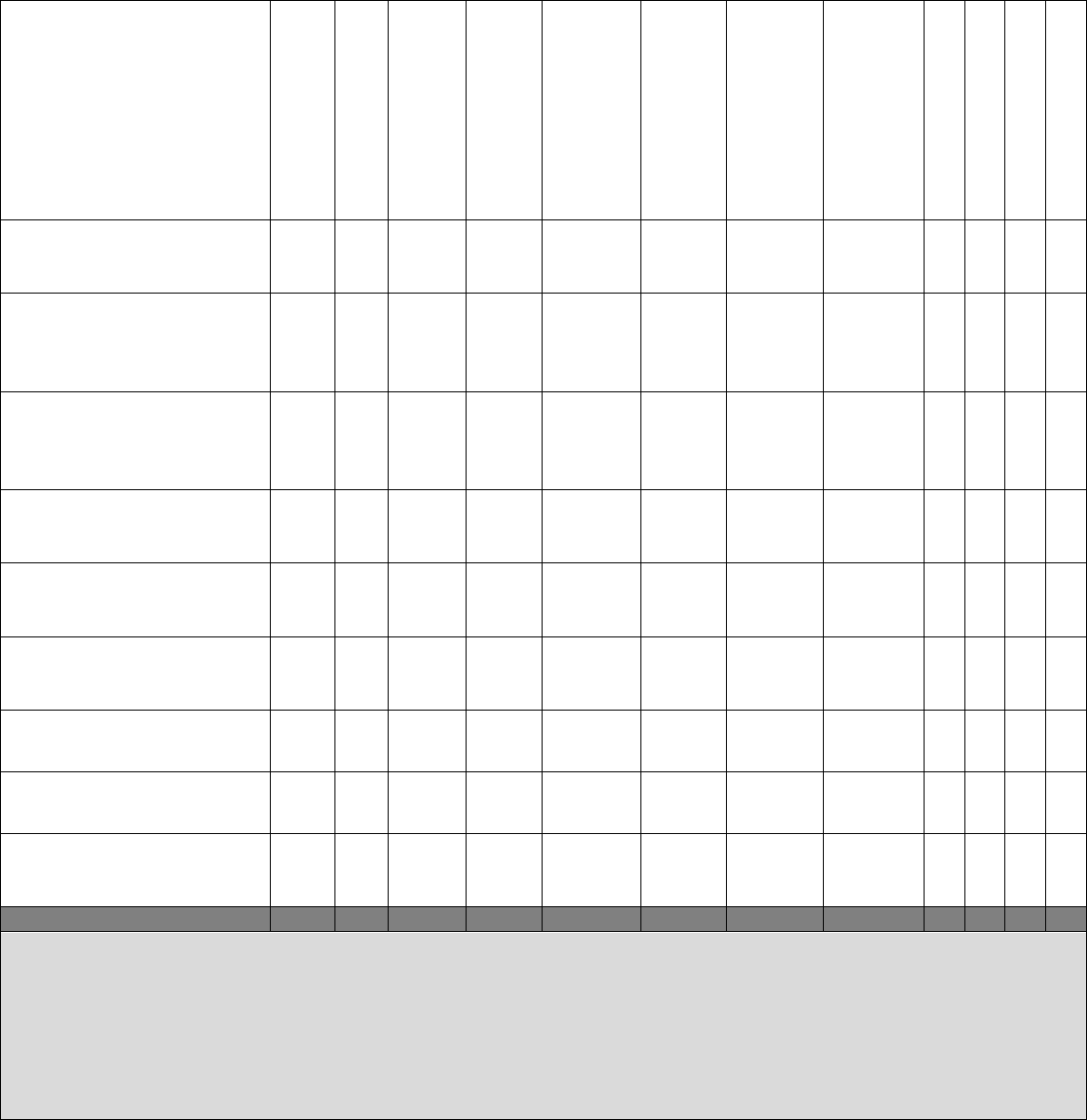
42
1. Tasks, Knowledge and
Technical References
Behavior Match
Core/Cert
Deployment * / SEI +
CBRN/TQT ♦
Trng
Start
Trng
Complete
Trainee
Initials
Trainer
Initials
Certifier
Initials
3-
lvl
5-
lvl
7-
lvl
9-
lvl
1.3.4.1. Validate and approve
changes to HHQ enlisted grade
review
1
-
-
-
-
-
-
1.3.4.2. Analyze manning levels
and impacts on total force
capabilities within AF
constraints
1
-
-
-
-
-
-
1.3.4.3. Coordinate with
appropriate agencies to evaluate
manpower standards and resolve
concerns
2
-
-
-
-
-
-
1.3.4.4. Balance manpower
capabilities with authorized
funded allocations
2
7/R
-
-
-
-
-
1.3.4.5. Justify manpower
movements to appropriate
stakeholders
2
7/R
-
-
-
-
-
1.3.4.6. Incorporate strategic
vision objectives' impact on
manpower authorizations
2
-
-
-
-
-
-
1.3.4.7. Implement industry best
practices
3
-
-
-
-
-
-
1.3.4.8. Prioritize resourcing for
innovation projects
3
-
-
-
-
-
-
1.3.4.9. Encourage enterprise-
wide innovation mindset
3
-
-
-
-
-
-
2. COMMUNICATION
2.1. COMMUNICATION
Description: Presenting clear, concise, and meticulous verbal and written information through active listening and clear messaging, to
achieve mission goals, improve processes, and eliminate errors.
Supporting Competencies: Relationship Building, Accountability, Precision, Flexibility
TR: DAFI 90-160, DAFMAN 36-2689, DAFH 33-337, AFMAN 33-326

43
1. Tasks, Knowledge and
Technical References
Behavior Match
Core/Cert
Deployment * / SEI +
CBRN/TQT ♦
Trng
Start
Trng
Complete
Trainee
Initials
Trainer
Initials
Certifier
Initials
3-
lvl
5-
lvl
7-
lvl
9-
lvl
2.1.1. COMMUNICATION BASIC
Required Behaviors:
1) Employs communication methods and tools (e.g., written, verbal, and electronic formats) to effectively manage unit programs
2) Presents clear, accurate, error free communication in support of the customer
3) Informs stakeholders on program status and overall health to ensure mission effectiveness
Criteria:
Consistency of Application: Sustained application of competency overtime
2.1.1.1. Identify and apply
communication techniques IAW
approved guidance and source
references, (e.g., verbal, visual,
and written, etc.)
1
-
-
P
-
-
-
2.1.1.2. Utilize digital
applications for communication
1
5
♦
P
-
-
-
2.1.1.3. Apply OPSEC and
COMSEC through all forms of
communication
1
-
♦
-
-
-
-
2.1.1.4. Provide presentations to
inform personnel on program
requirements (e.g., verbal,
visual, and written, etc.)
2
5
-
P
-
-
-
2.1.1.5. Convey clear and
concise communications
(verbal, visual, and written)
2
5
-
P
-
-
-
2.1.1.6. Communicate with a
positive physical presence to
ensure body language is open
and approachable
2
5
-
P
-
-
-
2.1.1.7. Clearly communicate
status and turn over
2
-
♦
-
-
-
-
2.1.1.8. Identify proper email
and social media etiquette
2
-
-
-
K
-
-
2.1.1.9. Speak to an individual
or audience in an engaging and
clear manner
2
5
-
P
-
-
-

44
1. Tasks, Knowledge and
Technical References
Behavior Match
Core/Cert
Deployment * / SEI +
CBRN/TQT ♦
Trng
Start
Trng
Complete
Trainee
Initials
Trainer
Initials
Certifier
Initials
3-
lvl
5-
lvl
7-
lvl
9-
lvl
2.1.1.10. Communicate
milestones and outcomes with
internal and external
stakeholders
3
5
-
-
-
-
-
2.1.1.11. Identify local
procedures for communicating
with the chain of command
3
-
♦
-
-
-
-
2.1.2. COMMUNICATION INTERMEDIATE
Required Behaviors:
1) Collaborates with personnel and shares information to keep stakeholders and customers actively engaged
2) Tailors communication techniques to address identified concerns or desires to various or diverse audiences to ensure message is received
in a non-hostile manner
3) Utilizes all five types of communication (e.g., written, visual, verbal, non-verbal, and active listening) to provide integrated ideas,
direction or support across an organization in order to meet mission priorities
Criteria:
Consistency of Application: Sustained application of competency over time in a variety of situation
2.1.2.1. Utilize approved and
appropriate communication
systems to engage with and
disseminate information to
customers
1
5
-
-
-
-
-
2.1.2.2. Develop relationships
and builds a professional
network
1
5
-
-
-
-
-
2.1.2.3. Recognize
differences/similarities in target
audience and adjust delivery
2
-
-
-
-
-
-
2.1.2.4. Apply conflict
management resolution
techniques
2
7
-
-
-
-
-
2.1.2.5. Recognize unconscious
bias and utilize techniques to
overcome obstacles
2
5
-
-
-
-
-

45
1. Tasks, Knowledge and
Technical References
Behavior Match
Core/Cert
Deployment * / SEI +
CBRN/TQT ♦
Trng
Start
Trng
Complete
Trainee
Initials
Trainer
Initials
Certifier
Initials
3-
lvl
5-
lvl
7-
lvl
9-
lvl
2.1.2.6. Anticipate and adapt to
technical difficulties by creating
alternate communication means
(e.g., rehearse brief, familiarity
with content, back-up
presentation methods, paper
copies)
2
5
-
-
-
-
-
2.1.2.7. Conduct research,
compile information, and
provide a comprehensive
presentation
3
5
-
-
-
-
-
2.1.2.8. Apply interpersonal
skills (e.g., emotional
intelligence, non-verbal, tone,
volume, and words) to direct,
inform, and persuade
3
5
-
-
-
-
-
2.1.2.9. Utilize verbal and non-
verbal techniques to show and
keep attention of the stakeholder
(e.g., open-ended and
exploratory questions, eye
contact)
3
5
-
P
-
-
-
2.1.2.10. Utilize active listening
techniques
3
5
-
-
-
-
-
2.1.2.11. Identify and select
optimal forms of
communication to ensure
successful messaging (e.g.,
written, visual, verbal)
3
5
-
-
-
-
-
2.1.3. COMMUNICATION ADVANCED
Required Behaviors:
1) Initiates cross-organizational communication to synchronize actions and behaviors to achieve a cohesive objective
2) Interprets highly technical subjects or ambiguous information from multiple sources to affect program changes or improvements
3) Identifies and employs new methods of communication to effectively transfer information throughout organizations
Criteria:
Consistency of Application: Sustained application of competency over time in complex situations
2.1.3.1. Perform an after-action
assessment (hot wash, debrief,
etc.) on major projects
1
7
-
-
-
-
-

46
1. Tasks, Knowledge and
Technical References
Behavior Match
Core/Cert
Deployment * / SEI +
CBRN/TQT ♦
Trng
Start
Trng
Complete
Trainee
Initials
Trainer
Initials
Certifier
Initials
3-
lvl
5-
lvl
7-
lvl
9-
lvl
2.1.3.2. Resolve
complaints/disagreements and
communicate those actions to all
parties involved
1
7
-
-
-
-
-
2.1.3.3. Seek ideas, concerns,
and questions from others
1
-
-
-
-
-
-
2.1.3.4. Manage and
communicate project risks,
failures, or setbacks with
stakeholders
1
7
-
-
-
-
-
2.1.3.5. Formulate and deliver
comprehensive courses of action
to inform the decision-making
authority
1
7
-
-
-
-
-
2.1.3.6. Leverage negotiation
techniques to achieve consensus
1
7
-
-
-
-
-
2.1.3.7. Incorporate leadership
vision into task assignment and
execution
2
7
-
-
-
-
-
2.1.3.8. Identify the needs and
goals of leadership and other
stakeholders
2
-
-
-
-
-
-
2.1.3.9. Establish and maintain
expectations for internal and
external stakeholders
concerning participation, project
updates, and objectives/goals
2
-
-
-
-
-
-
2.1.3.10. Consider Volatile,
Uncertain, Complex,
Ambiguous (VUCA) challenges
while developing/executing
communication strategy
2
-
-
-
-
-
-
2.1.3.11. Anticipate potential
questions or concerns to provide
leadership with additional
supporting data when presenting
2
5
-
pk
-
-
-
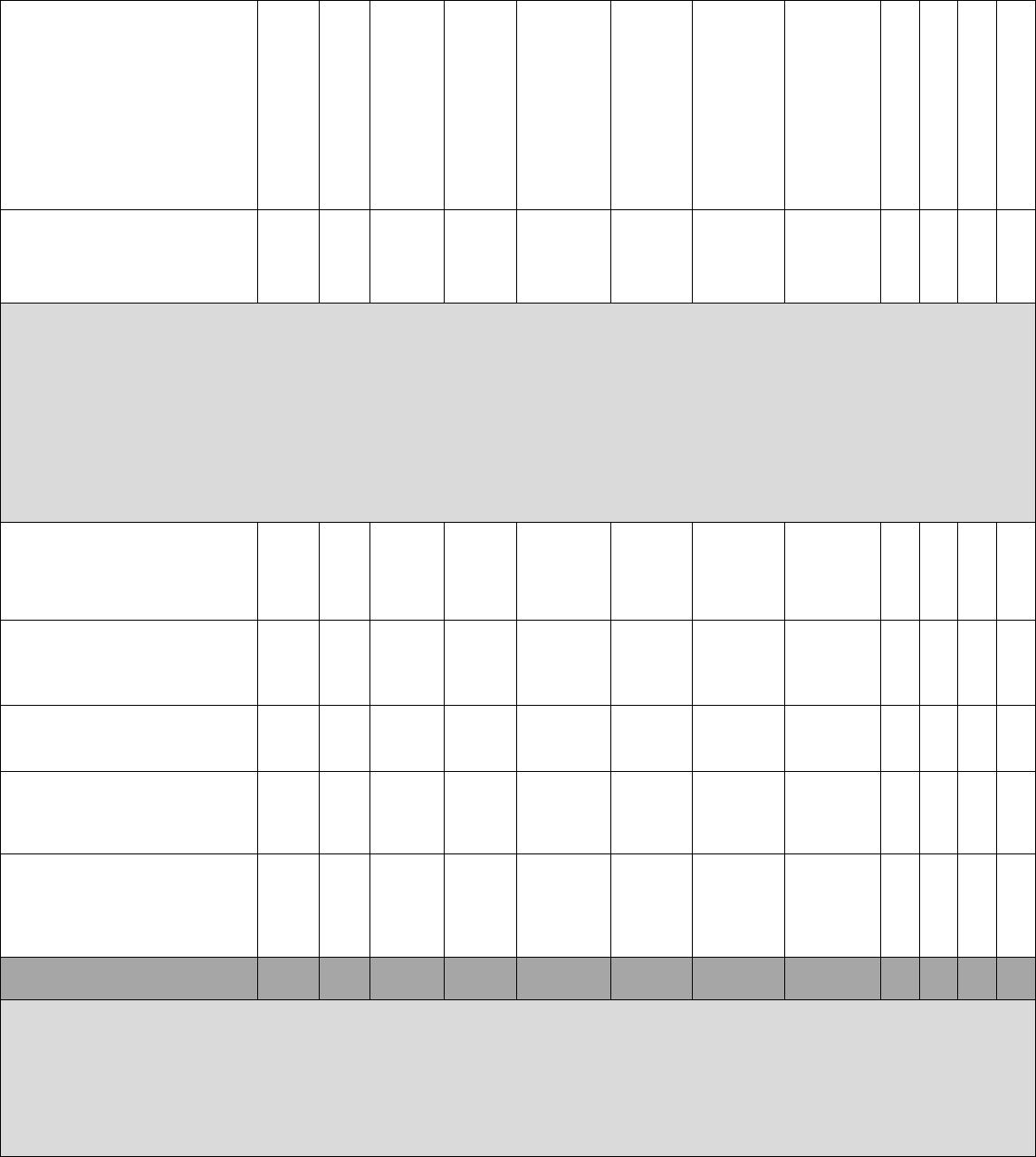
47
1. Tasks, Knowledge and
Technical References
Behavior Match
Core/Cert
Deployment * / SEI +
CBRN/TQT ♦
Trng
Start
Trng
Complete
Trainee
Initials
Trainer
Initials
Certifier
Initials
3-
lvl
5-
lvl
7-
lvl
9-
lvl
2.1.3.12. Investigate and utilize
emerging techniques to
overcome communication
barriers
3
7
-
-
-
-
-
2.1.4. COMMUNICATION EXPERT
Required Behaviors:
1) Develops and delivers complex information to translate strategic intent into operational guidance to meet organizational priorities
2) Guides personnel on utilization of various communication methods and tools in order to deliver desired message
Criteria:
Consistency of Application: Able to innovate and formulate strategies: able to model/guide/teach others the competency of how to apply the
competency
2.1.4.1. Translate strategic
messaging into actionable
objectives
1
-
-
-
-
-
-
2.1.4.2. Formulate and
summarize critical thinking
perspectives to senior leaders
1
7
-
-
-
-
-
2.1.4.3. Provide guidance of
strategic messaging at all levels
2
-
-
-
-
-
-
2.1.4.4. Deliver leadership
orders, guidance and messages
in a professional manner
2
-
-
-
-
-
-
2.1.4.5. Apply tactics to
influence others in writing,
speaking, and visual means
2
-
-
-
-
-
-
3. TRAINING
MANAGEMENT
3.1. PROGRAM MANAGEMENT
Description: Managing programs mapped to mission priorities or objectives that improve organizational performance.
Supporting Competencies: Organizational Awareness, Accountability, Information Seeking, Decision Making
TR: AFI 25-201, AFI 36-2650, AFI 38-401, AFI 90-201, AFMAN 33-326, CFETP 3F2X1, DAFH 33-337, DAFMAN 36-2689,
HOI 90-1 attach 3

48
1. Tasks, Knowledge and
Technical References
Behavior Match
Core/Cert
Deployment * / SEI +
CBRN/TQT ♦
Trng
Start
Trng
Complete
Trainee
Initials
Trainer
Initials
Certifier
Initials
3-
lvl
5-
lvl
7-
lvl
9-
lvl
3.1.1. PROGRAM MANAGEMENT BASIC
Required Behaviors:
1) Articulates procedures and standards on applicable programs to inform leaders on program status
2) Applies project management techniques to execute program requirements to assist personnel
3) Safeguards information to ensure data integrity and personnel privacy
Criteria:
Impact on: Specific workplace tasks
3.1.1.1. Articulate roles and
responsibilities for program
stakeholders
1
5
-
-
pk
-
-
3.1.1.2. Adhere to program
standardization process to
ensure compliance
1
-
-
-
-
-
-
3.1.1.3. Perform follow up
actions based on timeline and
milestones
1
5
-
-
pk
-
-
3.1.1.4. Collect, organize, and
supply deliverables
1
5
-
-
pk
-
-
3.1.1.5. Track timelines and
milestones to meet objectives
2
5
-
-
pk
-
-
3.1.1.6. Utilize project
management tools to gather data
and generate reports
2
5
-
-
pk
-
-
3.1.1.7. Visit work centers to
establish rapport
2
-
-
-
-
-
-
3.1.1.8. Manage system
accounts to maintain
accountability and access
3
5
-
-
pk
-
-
3.1.1.9. Identify ways to
safeguard information of unit
personnel
3
5
-
-
pk
-
-

49
1. Tasks, Knowledge and
Technical References
Behavior Match
Core/Cert
Deployment * / SEI +
CBRN/TQT ♦
Trng
Start
Trng
Complete
Trainee
Initials
Trainer
Initials
Certifier
Initials
3-
lvl
5-
lvl
7-
lvl
9-
lvl
3.1.1.10. Identify and address
system issues
3
-
-
-
-
-
-
3.1.2. PROGRAM MANAGEMENT INTERMEDIATE
Required Behaviors:
1) Utilizes time management to effectively oversee a multitude of programs for organizational mission accomplishment
2) Integrates routine operations while adapting to program revisions for seamless execution of requirements in support of customers
Criteria:
Impact on: Specific workplace projects
3.1.2.1. Develop timelines and
milestones to meet objectives
1
7
-
-
-
-
-
3.1.2.2. Prioritize appropriate
tasks across multiple program
requirements
1
7
-
-
-
-
-
3.1.2.3. Apply knowledge and
application of program
management methodology and
techniques
1
-
-
-
-
-
-
3.1.2.4. Communicate delays
and propose solutions with
stakeholders to mitigate mission
impact
1
5
-
-
-
-
-
3.1.2.5. Troubleshoot system
issues for users
2
5
-
-
-
-
-
3.1.2.6. Interpret policy and
guidance to assist w/ program
development standardization
2
-
-
-
-
-
-
3.1.2.7. Approve and
disseminate deliverables
2
5
-
-
-
-
-
3.1.2.8. Consolidate and submit
program improvement
recommendations to next higher
level or appropriate office
2
-
-
-
-
-
-

50
1. Tasks, Knowledge and
Technical References
Behavior Match
Core/Cert
Deployment * / SEI +
CBRN/TQT ♦
Trng
Start
Trng
Complete
Trainee
Initials
Trainer
Initials
Certifier
Initials
3-
lvl
5-
lvl
7-
lvl
9-
lvl
3.1.2.9. Utilize trend analysis to
provide resolution for frequent
user errors/issues
2
-
-
-
-
-
-
3.1.2.10. Identify and adhere to
formal agreements (MOU,
MOA, SOP, OI, etc.)
2
-
-
-
pk
-
-
3.1.2.11. Identify and explain
program management tools and
resources to standardize
utilization
2
-
-
-
-
-
-
3.1.3. PROGRAM MANAGEMENT ADVANCED
Required Behaviors:
1) Partners with higher-level leadership to provide recommended courses of actions and enhancements
2) Solves program challenges to achieve mission priorities
Criteria:
Impact on: Management decisions
3.1.3.1. Leverage data to
identify and mitigate program
deficiency to ensure continual
process improvement
1
-
-
-
-
-
-
3.1.3.2. Inform and recommend
program changes to decision
makers
1
-
-
-
-
-
-
3.1.3.3. Develop local processes
to align program with
installation requirements and
resources
2
-
-
-
-
-
-
3.1.3.4. Analyze standardized
program processes to identify
where local deviations are
required
2
-
-
-
-
-
-
3.1.3.5. Execute program self-
assessment to resolve shortfalls
2
-
-
-
-
-
-
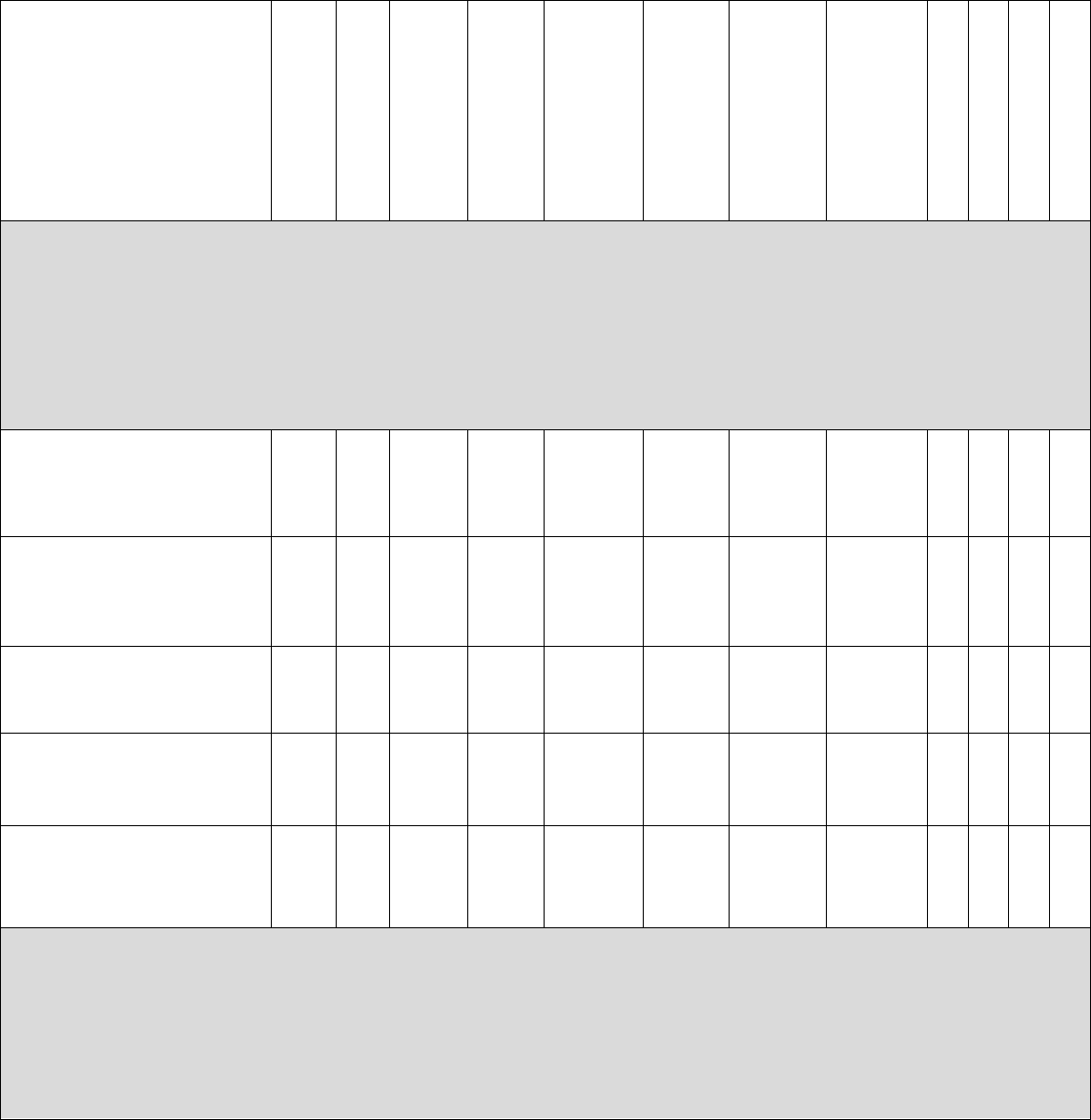
51
1. Tasks, Knowledge and
Technical References
Behavior Match
Core/Cert
Deployment * / SEI +
CBRN/TQT ♦
Trng
Start
Trng
Complete
Trainee
Initials
Trainer
Initials
Certifier
Initials
3-
lvl
5-
lvl
7-
lvl
9-
lvl
3.1.4. PROGRAM MANAGEMENT EXPERT
Required Behaviors:
1) Solves program limitations and directs revisions for enterprise-wide success
2) Advises and coordinates with policy managers outside the functional community to advocate for program implementation across the
enterprise
Criteria:
Impact on: Air Force level practices/within industry
3.1.4.1. Research and advocate
for industry technologies
applicable to career field
programs
1
-
-
-
-
-
-
3.1.4.2. Establish enterprise-
wide standard operating
procedures (SOP) across policy
and doctrine
1
-
-
-
-
-
-
3.1.4.3. Explain and disseminate
strategic messaging to educate
stakeholders
2
-
-
-
-
-
-
3.1.4.4. Incorporate historical
trends and future requirements
in decision-making practices
2
-
-
-
-
-
-
3.1.4.5. Collaborate with cross
functional SMEs to identify best
practices and future projects
2
-
-
-
-
-
-
3.2. UPGRADE TRAINING AND QUALIFICATION
Description: Focused execution of an individual's career progression in their skills, knowledge, abilities, and other characteristics
manifested in behaviors to accomplish the mission within their specific functional community.
Supporting Competencies: Develops People, Organizational Awareness, Accountability, Information Seeking
TR: DAFMAN 36-2689, DAFI 90-160, UTM PSDG, LMS QRGs, AFI 36-2650, DAFH 36-2675, DAFMAN 36-2664

52
1. Tasks, Knowledge and
Technical References
Behavior Match
Core/Cert
Deployment * / SEI +
CBRN/TQT ♦
Trng
Start
Trng
Complete
Trainee
Initials
Trainer
Initials
Certifier
Initials
3-
lvl
5-
lvl
7-
lvl
9-
lvl
3.2.1. UPGRADE TRAINING AND QUALIFICATION BASIC
Required Behaviors:
1) Conducts interviews to identify training needs to meet training requirements
2) Tracks training requirements for assigned personnel to ensure qualifications are met
3) Manages and updates applicable training systems to ensure information accuracy
4) Reports training data to enable senior leaders to make informed decision and provide corrective actions
Criteria:
Consistency of Application: Sustained application of competency over time
3.2.1.1. Identify individual
training requirements for
assigned AFSCs
1
5
-
K
K
-
-
3.2.1.2. Interview newly
assigned personnel to identify
current training status
1
5
-
P
pk
-
-
3.2.1.3. Document training
status on the OJT roster
2
5
-
P
pk
-
-
3.2.1.4. Analyze an On-the-Job
Training (OJT) roster to track
members training status
2
5
-
P
pk
-
-
3.2.1.5. Track and report
ancillary training requirements
for assigned personnel
2
5
-
P
pk
-
-
3.2.1.6. Manage mandatory
training requirements (CDCs,
DL courses, advanced courses,
core tasks, etc.)
2
5
-
P
pk
-
-
3.2.1.7. Schedule personnel for
training using established
guidance and processes
2
5
-
-
pk
-
-
3.2.1.8. Maintain training
records
2
5
-
pk
pk
-
-
3.2.1.9. Review applicable
publication and inform
supervisors of CFETP, STS and
AFJQS changes
2
-
-
P
pk
-
-

53
1. Tasks, Knowledge and
Technical References
Behavior Match
Core/Cert
Deployment * / SEI +
CBRN/TQT ♦
Trng
Start
Trng
Complete
Trainee
Initials
Trainer
Initials
Certifier
Initials
3-
lvl
5-
lvl
7-
lvl
9-
lvl
3.2.1.10. Review and process
training forms
3
5
-
P
pk
-
-
3.2.1.11. Update TSC and
AFSC in accordance with
prescribed guidance
3
5
-
P
pk
-
-
3.2.1.12. Update Date Initially
Entered Retraining (DIERT) for
applicable personnel
3
5
-
P
pk
-
-
3.2.1.13. Update Learning
Management Systems for
assigned personnel
3
5
-
P
pk
-
-
3.2.1.14. Conduct Training
Performance Metrics (TPM)
briefing with leadership
4
5
-
P
pk
-
-
3.2.2. UPGRADE TRAINING AND QUALIFICATION INTERMEDIATE
Required Behaviors:
1) Assesses work center priorities to help create accurate training plans
2) Advises and assists assigned personnel in completing their responsibilities to meet training requirements
3) Coordinates training for assigned personnel and collaborates with training providers to support mission readiness
Criteria:
Consistency of Application: Sustained application of competency over time in variety of situations
3.2.2.1. Monitor and evaluate
effectiveness of training
1
5
-
-
pk
-
-
3.2.2.2. Assist with developing a
training plan
1
-
-
P
-
-
-
3.2.2.3. Conduct training
meetings and document minutes
2
5
-
P
pk
-
-
3.2.2.4. Communicate with
supervisor on trainee progress
2
5
-
-
pk
-
-
3.2.2.5. Visit work center to
build rapport and assess training
environment
2
5
-
-
pk
-
-

54
1. Tasks, Knowledge and
Technical References
Behavior Match
Core/Cert
Deployment * / SEI +
CBRN/TQT ♦
Trng
Start
Trng
Complete
Trainee
Initials
Trainer
Initials
Certifier
Initials
3-
lvl
5-
lvl
7-
lvl
9-
lvl
3.2.2.6. Assist supervisors in
developing corrective action
plan for personnel who fail to
progress in training
2
5
-
-
pk
-
-
3.2.2.7. Coordinate formal
training requests including
Mobile Training Teams (MTT)
3
-
-
-
-
-
-
3.2.2.8. Identify lack of training
capability
3
-
-
-
-
-
-
3.2.2.9. Coordinate AFTC
3
5
-
-
pk
-
-
3.2.3. UPGRADE TRAINING AND QUALIFICATION ADVANCED
Required Behaviors:
1) Forecasts education and training requirements to determine validity and attainability
2) Interprets and communicates strategic vision and training guidance to enable customers in meeting requirements
Criteria:
Consistency of Application: Sustained application of competency over time in complex situations
3.2.3.1. Direct Data Calls
1
-
-
-
-
-
-
3.2.3.2. Provide guidance and
policy interpretation to
subordinate units
2
-
-
-
-
-
-
3.2.4. UPGRADE TRAINING AND QUALIFICATION EXPERT
Required Behaviors:
1) Develops and updates training policies and procedures to improve training effectiveness
2) Consults with stakeholders to develop innovative solutions to enhance the organization’s training program
Criteria:
Consistency of Application: Able to innovate and formulate strategies; able to model/guide/teach other the competency of how to apply the
competency
3.2.4.1. Develop training
guidance and policy
1
-
-
-
-
-
-
3.2.4.2. Analyze and monitor
training data and updates policy
as needed
1
-
-
-
-
-
-

55
1. Tasks, Knowledge and
Technical References
Behavior Match
Core/Cert
Deployment * / SEI +
CBRN/TQT ♦
Trng
Start
Trng
Complete
Trainee
Initials
Trainer
Initials
Certifier
Initials
3-
lvl
5-
lvl
7-
lvl
9-
lvl
3.2.4.3. Realign career field
training priorities using
evaluation data and feedback
from the field
1
-
-
-
-
-
-
3.2.4.4. Collaborate with
stakeholders to resolve
problems with training
2
-
-
-
-
-
-
3.2.4.5. Advocate for functional
community, addressing issues,
and coordinating specialty
concerns across various staffs
2
-
-
-
-
-
-
3.3. COURSE MANAGEMENT
Description: Deliberate administration of formal and informal programs to comply with the needs and standards of the individual's
continuum of learning.
Supporting Competencies: Information Seeking, Organizational Awareness, Initiative, Flexibility
TR: DAFMAN 36-2689, AFMAN 36-2100, ETCA, AFI 36-2650, AFMAN 33-326, DAFH 36-2675, DAFMAN 36-2664
3.3.1. COURSE MANAGEMENT BASIC
Required Behaviors:
1) Identifies course needs for assigned personnel for continued advancement
2) Communicates with key stakeholders and validates training requests for upgrade and qualification needs
3) Schedules training events based on identified requirements for progression in the continuum of learning
Criteria:
Impact on: Specific workplace task
3.3.1.1. Identify training for
assigned personnel to meet
mission requirements
1
5
-
-
K
-
-
3.3.1.2. Notify stakeholders of
training needs
2
-
-
-
-
-
-
3.3.1.3. Advise leadership of
mission impact due to training
shortfalls
2
-
-
-
-
-
-
3.3.1.4. Compile training needs
and validate prerequisites,
mission requirements, and
availability
2
5
-
-
pk
-
-

56
1. Tasks, Knowledge and
Technical References
Behavior Match
Core/Cert
Deployment * / SEI +
CBRN/TQT ♦
Trng
Start
Trng
Complete
Trainee
Initials
Trainer
Initials
Certifier
Initials
3-
lvl
5-
lvl
7-
lvl
9-
lvl
3.3.1.5. Follow local process
and guidance to request training
3
5
-
-
pk
-
-
3.3.1.6. Secure training for
assigned personnel to meet
mission requirements
3
5
-
-
pk
-
-
3.3.2. COURSE MANAGEMENT INTERMEDIATE
Required Behaviors:
1) Consolidates course requests to build class schedules and commits resource allocations to meet training demands
2) Disseminates schedules and course information to maximize course utilization
3) Collaborates with outside agencies to obtain allocations and budget management to meet training demands
Criteria:
Impact on: Specific workplace projects
3.3.2.1. Initiate training forecast
with supported agencies
1
5
-
-
pk
-
-
3.3.2.2. Compile training
forecast needs
1
5
-
-
pk
-
-
3.3.2.3. Build class based on
course parameters and mission
needs
1
-
-
-
-
-
-
3.3.2.4. Secure resources to
meet training demands
1
-
-
-
-
-
-
3.3.2.5. Publish and disseminate
schedules to ensure members
and leaders receive class
information
2
-
-
-
-
-
-
3.3.2.6. Identify training
capability shortfalls
3
-
-
-
-
-
-
3.3.2.7. Foster relationship with
outside agencies to acquire
additional allocations
3
-
-
-
-
-
-
3.3.2.8. Collaborate with
resource advisor to acquire
funding to meet training
demands
3
-
-
-
-
-
-

57
1. Tasks, Knowledge and
Technical References
Behavior Match
Core/Cert
Deployment * / SEI +
CBRN/TQT ♦
Trng
Start
Trng
Complete
Trainee
Initials
Trainer
Initials
Certifier
Initials
3-
lvl
5-
lvl
7-
lvl
9-
lvl
3.3.3. COURSE MANAGEMENT ADVANCED
Required Behaviors:
1) Develops guidelines and directives for course management utilization and publishes guidance through various platforms
2) Implements prerequisites parameters and determines equitable allocations of demands
Criteria:
Impact on: Management decisions
3.3.3.1. Establish course
scheduling and request process
1
-
-
-
-
-
-
3.3.3.2. Publish guidance to
stakeholders
1
-
-
-
-
-
-
3.3.3.3. Advertise nominative
opportunities to key leaders for
highly coveted courses to
develop talent
1
-
-
-
-
-
-
3.3.3.4. Identify course and
application requirements
2
-
-
-
-
-
-
3.3.3.5. Establish prioritization
gates and distribution equity
2
-
-
-
-
-
-
3.3.4. COURSE MANAGEMENT EXPERT
Required Behaviors:
1) Generates needs assessment for new training demands
2) Advocates for new course requirements and resources specified for developmental needs in the career field
3) Implements course validation policy for target audience
Criteria:
Impact on: Air Force level practices/within industry
3.3.4.1. Survey training needs
1
-
-
-
-
-
-
3.3.4.2. Collaborate with
subject-matter experts to
confirm training requirements
1
-
-
-
-
-
-
3.3.4.3. Determine need for
course update or creation
2
-
-
-
-
-
-

58
1. Tasks, Knowledge and
Technical References
Behavior Match
Core/Cert
Deployment * / SEI +
CBRN/TQT ♦
Trng
Start
Trng
Complete
Trainee
Initials
Trainer
Initials
Certifier
Initials
3-
lvl
5-
lvl
7-
lvl
9-
lvl
3.3.4.4. Prioritize resource
allocations to address
progressive enterprise-wide
requirements
2
-
-
-
-
-
-
3.3.4.5. Establish validation
plan
3
-
-
-
-
-
-
3.4. TESTING MANAGEMENT
Description: Enforcing academic integrity by executing testing processes.
Supporting Competencies: Accountability, Precision, Digital Literacy, Results Focused
TR: AFI 38-401, AFI 36-2650, DAFMAN 36-2664, DAFMAN 36-2689
3.4.1. TESTING MANAGEMENT BASIC
Required Behaviors:
1) Executes testing procedures to enable testing facility process
2) Directs customers to appropriate and pertinent study material and resources to ensure preparedness
Criteria:
Impact on: Specific Workplace Task
3.4.1.1. Identify, interpret, and
articulate regulatory guidance
for test procedures
1
-
*
-
-
-
-
3.4.1.2. Proctor testing IAW
applicable directives
1
-
*
-
-
-
-
3.4.1.3. Validate and follow post
test administration and
disposition procedures
1
-
*
-
-
-
-
3.4.1.4. Determine customer
requirements
2
-
*
-
-
-
-
3.4.1.5. Advise customers of
resources for test preparation
2
-
*
-
-
-
-

59
1. Tasks, Knowledge and
Technical References
Behavior Match
Core/Cert
Deployment * / SEI +
CBRN/TQT ♦
Trng
Start
Trng
Complete
Trainee
Initials
Trainer
Initials
Certifier
Initials
3-
lvl
5-
lvl
7-
lvl
9-
lvl
3.4.2. TESTING MANAGEMENT INTERMEDIATE
Required Behaviors:
1) Maintains current test facility validation to ensure test security, integrity, and inventory
2) Standardizes the process for test preparation, facilitation, and uploading completion for education advancement
Criteria:
Impact on: Specific Workplace Projects
3.4.2.1. Conduct inventories on
assigned test facility
accountable assets
1
-
*
-
-
-
-
3.4.2.2. Enforce policies to
secure and validate testing
environment
1
-
*
-
-
-
-
3.4.2.3. Establish security
measures to ensure testing
procedure integrity
1
-
*
-
-
-
-
3.4.2.4. Develop local process to
standardize testing
administration and disposition
procedures
2
-
*
-
-
-
-
3.4.3. TESTING MANAGEMENT ADVANCED
Required Behaviors:
1) Analyzes reliability and accuracy of tests to provide recommendations to senior leadership
2) Identifies improvements and implements schedule and procedure revisions to accommodate mission demands
3) Executes necessary actions to support test compromise procedures
Criteria:
Impact on: Management decisions
3.4.3.1. Formulate and deliver
comprehensive CoAs to inform
the decision-making authority
on test validity
1
-
-
-
-
-
-
3.4.3.2. Report test change
recommendation to appropriate
authorities
1
-
-
-
-
-
-
3.4.3.3. Conduct trend analysis
to identify testing inaccuracies
1
-
-
-
-
-
-

60
1. Tasks, Knowledge and
Technical References
Behavior Match
Core/Cert
Deployment * / SEI +
CBRN/TQT ♦
Trng
Start
Trng
Complete
Trainee
Initials
Trainer
Initials
Certifier
Initials
3-
lvl
5-
lvl
7-
lvl
9-
lvl
3.4.3.4. Apply process
improvement to identify and
implement local process
changes to alleviate mission
shortfalls
2
-
*
-
-
-
-
3.4.3.5. Execute applicable
guidance when test compromise
is suspected
3
-
*
-
-
-
-
3.4.3.6. Implement procedures
to prevent and identify test
compromise
3
-
*
-
-
-
-
3.4.4. TESTING MANAGEMENT EXPERT
Required Behaviors:
1) Builds relationships with neighboring testing centers to maintain alternative options
2) Develops and implements test management guidance to maintain academic integrity
Criteria:
Impact on: AF-level practices/within industry
3.4.4.1. Identify and foster
relationships with alternative
testing centers to minimize
negative mission impact
1
-
-
-
-
-
-
3.4.4.2. Collaborate with
alternative testing centers to
share best practices, templates,
and resources
1
-
-
-
-
-
-
3.4.4.3. Develop, revise, and
validate policy governing test
management procedures
2
-
-
-
-
-
-
4. INSTRUCTIONAL
SYSTEMS DESIGN (ISD)

61
1. Tasks, Knowledge and
Technical References
Behavior Match
Core/Cert
Deployment * / SEI +
CBRN/TQT ♦
Trng
Start
Trng
Complete
Trainee
Initials
Trainer
Initials
Certifier
Initials
3-
lvl
5-
lvl
7-
lvl
9-
lvl
4.1. CURRICULUM MANAGEMENT
Description: Designing and implementing instructional materials that meet mission objectives.
Supporting Competencies: Creative Thinking, Analytical Thinking, Strategic Thinking, Results Focused
TR: AFH 1, AFI 36-2650, DAFH 36-2675, DAFMAN 36-2689,
4.1.1. CURRICULUM MANAGEMENT BASIC
Required Behaviors:
1) Coordinates with stakeholders and subject matter experts to identify desired learning outcomes
2) Identifies training strategies aligning with learning outcomes to meet objectives
3) Integrates existing training materials into the design process to preserve resources
Criteria:
Consistency of Application: Sustained application of competency over time
4.1.1.1. Organize and facilitate
curriculum advisory committee
1
-
-
-
-
-
-
4.1.1.2. Develop objectives and
Course Control Documents
(CCD)
1
-
-
-
-
-
-
4.1.1.3. Design learning
objectives based off of desired
learning outcomes
2
-
-
-
-
-
-
4.1.1.4. Integrate diversity and
inclusion into course content
2
-
-
-
-
-
-
4.1.1.5. Coordinate training
resources and deconflict
organizational priorities to align
with scheduling needs
3
-
-
-
-
-
-
4.1.1.6. Utilize available
resources/templates for course
design and execution
3
-
-
-
-
-
-

62
1. Tasks, Knowledge and
Technical References
Behavior Match
Core/Cert
Deployment * / SEI +
CBRN/TQT ♦
Trng
Start
Trng
Complete
Trainee
Initials
Trainer
Initials
Certifier
Initials
3-
lvl
5-
lvl
7-
lvl
9-
lvl
4.1.2. CURRICULUM MANAGEMENT INTERMEDIATE
Required Behaviors:
1) Conducts task and learning analysis to identify requirements
2) Applies the steps of the instructional design process to build training materials in a variety of delivery platforms
3) Compiles data to make necessary adjustments to the instructional system
4) Develops assessment tools to identify and measure occupational requirements
Criteria:
Consistency of Application: Sustained application of competency over time in a variety of situations
4.1.2.1. Produce needs
assessment to determine
shortfalls
1
-
-
-
-
-
-
4.1.2.2. Analyze resource
availability
1
-
-
-
-
-
-
4.1.2.3. Analyze instructional
goals using required resources
for target audiences
1
-
-
-
-
-
-
4.1.2.4. Define measurable
actions to accomplish
instructional goals
1
-
-
-
-
-
-
4.1.2.5. Develop and validate
learning resources by
integrating content and
strategies for producing
guidance and supporting
objectives
2
-
-
-
-
-
-
4.1.2.6. Implement learning
solution by preparing learning
space and engage learning
environment
2
-
-
-
-
-
-
4.1.2.7. Ensure the quality of
continuous learning by
formative evaluation prior to
implementation to solidify
resources that satisfy learning
standards accomplishing
instructional goals
3
-
-
-
-
-
-

63
1. Tasks, Knowledge and
Technical References
Behavior Match
Core/Cert
Deployment * / SEI +
CBRN/TQT ♦
Trng
Start
Trng
Complete
Trainee
Initials
Trainer
Initials
Certifier
Initials
3-
lvl
5-
lvl
7-
lvl
9-
lvl
4.1.2.8. Create and utilize
feedback assessment tools for
course instructional analysis
4
-
-
-
-
-
-
4.1.3. CURRICULUM MANAGEMENT ADVANCED
Required Behaviors:
1) Analyzes data and makes recommendations to improve validity, effectiveness, and efficiency of instructional systems
2) Provides guidance and support to stakeholders and SMEs during the instructional development process
3) Evaluates course outcomes for fulfillment of operational objectives
Criteria:
Consistency of Application: Sustained application of competency over time in complex situations
4.1.3.1. Modernize curriculum
resources and content to adjust
for mission requirements and
policy changes
1
-
-
-
-
-
-
4.1.3.2. Assess course
curriculum and instructional
efficacy against learning
outcomes and objectives
1
-
-
-
-
-
-
4.1.3.3. Govern stakeholders
and suggests courses of action
for curriculum development and
implementation
2
-
-
-
-
-
-
4.1.3.4. Validate execution of
curriculum objectives to sync
with learning outcomes
3
-
-
-
-
-
-
4.1.4. CURRICULUM MANAGEMENT EXPERT
Required Behaviors:
1) Creates and influences processes that aligns mission, policy, and organizational values for instructional design
2) Teaches personnel on strategies of the instructional system process
3) Integrates emerging and advanced learning theories to make necessary adjustments to the development and design process
Criteria:
Consistency of Application: Able to innovate and formulate strategies; able to model/guide/teach others the competency of how to apply the
competency

64
1. Tasks, Knowledge and
Technical References
Behavior Match
Core/Cert
Deployment * / SEI +
CBRN/TQT ♦
Trng
Start
Trng
Complete
Trainee
Initials
Trainer
Initials
Certifier
Initials
3-
lvl
5-
lvl
7-
lvl
9-
lvl
4.1.4.1. Develop guidance and
instruction for curriculum
implementation and training
execution
1
-
-
-
-
-
-
4.1.4.2. Highlight instructional
curriculum competencies for
customer needs and mission
accomplishment
1
-
-
-
-
-
-
4.1.4.3. Educate stakeholders on
instructional design process
steps and course development
lifecycle
2
-
-
-
-
-
-
4.1.4.4. Implement innovative
curriculum design for
implementation of agile learning
outcomes
3
-
-
-
-
-
-
4.2. INSTRUCTION
Description: Delivering prescribed curriculum designed to develop an individual's skills, knowledge, abilities, and other characteristics
manifested in behaviors.
Supporting Competencies: Communication, Develops People, Flexibility, Relationship Building
TR: AFI 36-2650, DAFH 36-2675, DAFMAN 36-2689
4.2.1. INSTRUCTION BASIC
Required Behaviors:
1) Demonstrates instructional preparedness in the training environment
2) Applies instructional methods and strategies to keep students engaged, on-task, and on-schedule
3) Administers appropriate measurement device to assess student learning
4) Promotes inclusion and creates a safe learning environment for all individuals
Criteria:
Consistency of Application: Sustained application of competency over time
4.2.1.1. Prepare learning
environment and resources for
timely curriculum delivery
1
5
-
-
pk
-
-

65
1. Tasks, Knowledge and
Technical References
Behavior Match
Core/Cert
Deployment * / SEI +
CBRN/TQT ♦
Trng
Start
Trng
Complete
Trainee
Initials
Trainer
Initials
Certifier
Initials
3-
lvl
5-
lvl
7-
lvl
9-
lvl
4.2.1.2. Review course materials
in preparation to deliver
instruction
1
5
-
P
pk
-
-
4.2.1.3. Integrate interactions
and teaching techniques that
promote course standards and
learning objectives
2
-
-
-
-
-
-
4.2.1.4. Incorporate a variety of
teaching methodologies that
encourage dialog and
participation
2
-
-
-
-
-
-
4.2.1.5. Apply classroom
management strategies for
effective and efficient use of
instructional time
2
5
-
-
pk
-
-
4.2.1.6. Employ approved
metrics for learning objective
evaluations
3
-
-
-
-
-
-
4.2.1.7. Integrate diversity and
inclusion into course delivery
and student engagement
4
-
-
-
pk
-
-
4.2.1.8. Promote academic
freedom to encourage student
participation
4
-
-
-
-
-
-
4.2.1.9. Conduct AFTC as
needed
2
5
-
P
pk
-
-
4.2.2. INSTRUCTION INTERMEDIATE
Required Behaviors:
1) Employs multiple strategies that address differing learning styles (e.g., visual, oral, verbal, social, logical, spatial) of personnel
2) Modifies training strategies and instructional techniques based on student feedback and/or limitations
3) Identifies course deficiencies and provides feedback on curriculum content
Criteria:
Consistency of Application: Sustained application of competency over time in a variety of situation

66
1. Tasks, Knowledge and
Technical References
Behavior Match
Core/Cert
Deployment * / SEI +
CBRN/TQT ♦
Trng
Start
Trng
Complete
Trainee
Initials
Trainer
Initials
Certifier
Initials
3-
lvl
5-
lvl
7-
lvl
9-
lvl
4.2.2.1. Research learning styles
and preferences of students
1
-
-
-
-
-
-
4.2.2.2. Implement methods to
meet student learning styles and
preferences
1
-
-
-
-
-
-
4.2.2.3. Identify student
physical and cognitive
limitations to learning
2
5
-
-
pk
-
-
4.2.2.4. Adjust lesson content
and delivery to overcome
barriers which hinder student
learning
2
7
-
-
-
-
-
4.2.2.5. Review and process
course critiques to guide
instructional strategies and
techniques
2
5
-
-
pk
-
-
4.2.2.6. Analyze course
shortfalls and develop potential
solutions
3
-
-
-
-
-
-
4.2.2.7. Coordinate and propose
corrective actions with course
developers
3
-
-
-
-
-
-
4.2.3. INSTRUCTION ADVANCED
Required Behaviors:
1) Researches and implements new instructional techniques and technologies for delivery
2) Establishes adaptable and personalized learning environments dependent on real-time data, direct observation, and interaction with
personnel
Criteria:
Consistency of Application: Sustained application of competency over time in complex situations
4.2.3.1. Incorporate industry and
collegiate level standards into
tools, techniques, and
procedures for student
development and instructional
management design
1
-
-
-
-
-
-

67
1. Tasks, Knowledge and
Technical References
Behavior Match
Core/Cert
Deployment * / SEI +
CBRN/TQT ♦
Trng
Start
Trng
Complete
Trainee
Initials
Trainer
Initials
Certifier
Initials
3-
lvl
5-
lvl
7-
lvl
9-
lvl
4.2.3.2. Demonstrate real-time
flexibility within instructional
strategy and techniques to
achieve lesson objective
2
-
-
-
-
-
-
4.2.4. INSTRUCTION EXPERT
Required Behaviors:
1) Creates a supportive and challenging learning environment promoting professionalism, reflective practice, self-directed learning, self-
assessment, and lifelong learning
2) Trains personnel and provides feedback on proper techniques to enhance instruction
Criteria:
Consistency of Application: Able to innovate and formulate strategies; able to model/guide/teach others the competency of how to apply the
competency
4.2.4.1. Develop techniques to
encourage student-centered and
collaborative learning
environments
1
-
-
-
-
-
-
4.2.4.2. Adopt and integrate
emergent learning theories
(experiential, student-centered,
outcomes-based, etc.)
1
-
-
-
-
-
-
4.2.4.3. Facilitate instructor
growth through personalized
development plans and
instructional evaluation
2
-
-
-
-
-
-
5. PROGRAM
EFFECTIVENESS
5.1. DATA ANALYTICS
Description: Discovering, interpreting, and communicating significant trends.
Supporting Competencies: Analytical Thinking, Information Seeking, Digital Literacy, Organizational Awareness
TR: DAFMAN 36-2689, DAFI 21-101, AFI 36-2650

68
1. Tasks, Knowledge and
Technical References
Behavior Match
Core/Cert
Deployment * / SEI +
CBRN/TQT ♦
Trng
Start
Trng
Complete
Trainee
Initials
Trainer
Initials
Certifier
Initials
3-
lvl
5-
lvl
7-
lvl
9-
lvl
5.1.1. DATA ANALYTICS BASIC
Required Behaviors:
1) Retrieves data and collects statistical inputs for unit requirements and incorporates data for further analysis
2) Compiles data to illustrate training program effectiveness for key leaders
3) Communicates key performance indicators (KPI) for the effective and efficient mission parameters to unit leaders
4) Files and stores empirical data to ensure compliance with program requirements
Criteria:
Scope: Specific Area
5.1.1.1. Review local and Air
Force level policy to identify
required training
1
5
-
P
pk
-
-
5.1.1.2. Utilize various data
sources, systems of record, and
repositories to download and
review training data
1
5
-
-
pk
-
-
5.1.1.3. Accomplish training
data call for future mission
requirements
1
5
-
pk
pk
-
-
5.1.1.4. Apply analytical data
techniques and prepares training
visuals for applicable audience
2
5
-
P
pk
-
-
5.1.1.5. Present training visuals
to correlate training data to
mission effectiveness
3
5
-
P
pk
-
-
5.1.1.6. Follow records
management
policy/guidance/timelines
4
5
-
-
pk
-
-
5.1.2. DATA ANALYTICS INTERMEDIATE
Required Behaviors:
1) Identifies deficiencies and trends to evaluate overall training effectiveness
2) Correlates and differentiates implied statistical data to assist leaders to resolve training deficiencies, issues, and compliance within the
unit
Criteria:
Scope: Integration with concerned areas

69
1. Tasks, Knowledge and
Technical References
Behavior Match
Core/Cert
Deployment * / SEI +
CBRN/TQT ♦
Trng
Start
Trng
Complete
Trainee
Initials
Trainer
Initials
Certifier
Initials
3-
lvl
5-
lvl
7-
lvl
9-
lvl
5.1.2.1. Interpret and showcase
data fluctuations for trend
analysis in relation to mission
requirements
1
-
-
-
-
-
-
5.1.2.2. Audit collected data for
accuracy, accountability, and
usability in order to drive data
driven decisions
2
-
-
-
-
-
-
5.1.3. DATA ANALYTICS ADVANCED
Required Behaviors:
1) Examines statistical data from lower levels to highlight potential training gaps and determine viable solutions
2) Collaborates with functional community and leadership to determine benchmarked approaches to data provisions for implementation
3) Elevates substandard trends and concerns for solution determinations and guidance
Criteria:
Scope: Integration with organizational strategies
5.1.3.1. Integrate critical
thinking and problem-solving
techniques to identify training
shortfalls across all assigned
organizations
1
7
-
-
-
-
-
5.1.3.2. Utilize policy to resolve
training gaps at subordinate
units
1
7
-
-
-
-
-
5.1.3.3. Coordinate training and
information to enforce
standardized methods of
conducting data analytics based
on HHQ guidance
2
-
-
-
-
-
-
5.1.3.4. Partner with internal
and external SME working
groups to assist in resolving data
analytics shortfalls
2
-
-
-
-
-
-
5.1.3.5. Advocate for additional
resources to enable data driven
decisions
3
-
-
-
-
-
-

70
1. Tasks, Knowledge and
Technical References
Behavior Match
Core/Cert
Deployment * / SEI +
CBRN/TQT ♦
Trng
Start
Trng
Complete
Trainee
Initials
Trainer
Initials
Certifier
Initials
3-
lvl
5-
lvl
7-
lvl
9-
lvl
5.1.3.6. Elevate policy
inefficiencies for data analytics
to HHQ if unable to determine
viable solution
3
-
-
-
-
-
-
5.1.4. DATA ANALYTICS EXPERT
Required Behaviors:
1) Develops policy for data collection and analysis for achieving statistical objectives
2) Analyzes and interprets external guidance for functional community implementation
3) Enforces standardized approaches in expectations and gate-keeps other functional requirements for field implementation
4) Designs and regulates information timelines and structures channeling standardized execution for enterprise-wide operations
Criteria:
Scope: Integration with AF-level/within industry
5.1.4.1. Research and develop
new guidance to incorporate
data analytics into career field
requirements
1
-
-
-
-
-
-
5.1.4.2. Establish policy and
process for data collection from
outside sources
2
-
-
-
-
-
-
5.1.4.3. Incorporate external
agency or industry guidance into
functional data analytics
2
-
-
-
-
-
-
5.1.4.4. Codify training
instructions for enterprise level
implementation and execution
3
-
-
-
-
-
-
5.1.4.5. Filter joint regulations
for field implementation and
deconflict functional practices
with DoD expectations
4
-
*
-
-
-
-
5.1.4.6. Create and disseminate
Plans of Action and Milestones
(POAM) for data execution
4
-
-
-
-
-
-

71
1. Tasks, Knowledge and
Technical References
Behavior Match
Core/Cert
Deployment * / SEI +
CBRN/TQT ♦
Trng
Start
Trng
Complete
Trainee
Initials
Trainer
Initials
Certifier
Initials
3-
lvl
5-
lvl
7-
lvl
9-
lvl
5.2. ASSESSMENTS AND INSPECTIONS
Description: Providing objective and impartial appraisal regarding the condition of a program to continuously improve mission readiness.
Supporting Competencies: Accountability, Communication, Information Seeking, Organizational Awareness
TR: DAFMAN 36-2689, DAFMAN 36-2664
5.2.1. ASSESSMENTS AND INSPECTIONS BASIC
Required Behaviors:
1) Reviews pertinent information to identify training trends and gaps
2) Conducts inspections to evaluate work centers
3) Briefs stakeholders on inspections findings and provides recommended courses of action for improvement in mission readiness
4) Authors assessment reports and publishes for historical data to maintain training effectiveness
Criteria:
Scope: Specific Areas
5.2.1.1. Describe inspection
requirements and timelines
(CCIP, NSI, UEI, HSI, etc.)
1
5
-
-
K
-
-
5.2.1.2. Analyze historical
training program and inspection
data
1
5
-
-
pk
-
-
5.2.1.3. Conduct self-assessment
to measure compliance
2
5
-
pk
pk
-
-
5.2.1.4. Conduct a Staff
Assistance Visit (SAV) to
determine unit training program
health & welfare
2
5
-
pk
pk
-
-
5.2.1.5. Recommend
improvement areas
3
5
-
-
pk
-
-
5.2.1.6. Compile assessment
findings and publishes report
4
5
-
-
pk
-
-
5.2.1.7. Complete follow-up
actions
4
5
-
-
pk
-
-

72
1. Tasks, Knowledge and
Technical References
Behavior Match
Core/Cert
Deployment * / SEI +
CBRN/TQT ♦
Trng
Start
Trng
Complete
Trainee
Initials
Trainer
Initials
Certifier
Initials
3-
lvl
5-
lvl
7-
lvl
9-
lvl
5.2.2. ASSESSMENTS AND INSPECTIONS INTERMEDIATE
Required Behaviors:
1) Inspects base level programs and presents trend analysis for wing leadership awareness and decision making
2) Re-examines shortfalls in unit training programs and provides assistance to key personnel to implement recommended improvements
3) Composes inspection and assessment reports and elevates findings to leadership for advancement in training programs
Criteria:
Scope: Integration with concerned areas
5.2.2.1. Attend/complete
applicable IG training
1
-
-
-
-
-
-
5.2.2.2. Observe WIT inspection
1
-
-
-
-
-
-
5.2.2.3. Perform inspections
1
-
-
-
-
-
-
5.2.2.4. Identify repeat findings
1
-
-
-
-
-
-
5.2.2.5. Advise stakeholders on
Corrective Action Plans
2
-
-
-
-
-
-
5.2.2.6. Identify findings and
educate stakeholders on rebuttal
process
2
-
-
-
-
-
-
5.2.2.7. Assist in completion of
assessment report
3
-
-
-
-
-
-
5.2.2.8. Compile findings and
forward to appropriate agency
3
-
-
-
-
-
-
5.2.3. ASSESSMENTS AND INSPECTIONS ADVANCED
Required Behaviors:
1) Interprets internal assessments to provide sample plans and direction to IG teams
2) Continuously evaluates lower level self-assessment checklists for inclusion in strategic planning
3) Augments face-to-face inspections as directed by command leadership for lower level validation
4) Authors command specific policy and direction to guide inspectors for high interest items and concerns
Criteria:
Scope: Integration with organizational strategies
5.2.3.1. Pre-determine risk-
based sampling strategies
1
-
-
-
-
-
-

73
1. Tasks, Knowledge and
Technical References
Behavior Match
Core/Cert
Deployment * / SEI +
CBRN/TQT ♦
Trng
Start
Trng
Complete
Trainee
Initials
Trainer
Initials
Certifier
Initials
3-
lvl
5-
lvl
7-
lvl
9-
lvl
5.2.3.2. Implement continuous
evaluation plan
2
-
-
-
-
-
-
5.2.3.3. Implement MAJCOM
3F2 IG augmentee plan
3
-
-
-
-
-
-
5.2.3.4. Determine &
communicate MAJCOM
training inspection priorities
(e.g., CII)
4
-
-
-
-
-
-
5.2.3.5. Cross-tell best practices
with key stakeholders (e.g.,
pertinent oversight authorities)
4
-
-
-
-
-
-
5.2.3.6. Facilitate waiver
process
4
-
-
-
-
-
-
5.2.4. ASSESSMENTS AND INSPECTIONS EXPERT
Required Behaviors:
1) Develops policy for inspections and assessments within functional community
2) Creates checklists and criteria used by field to measure training effectiveness
3) Responds and develops inspection adjustments and issues between HHQ and unit level personnel
Criteria:
Scope: Integration with AF-level/within industry
5.2.4.1. Author training
inspection policy
1
-
-
-
-
-
-
5.2.4.2. Develop checklists for
end user
2
-
-
-
-
-
-
5.2.4.3. Establish and execute
policy adjustments
3
-
-
-
-
-
-
5.2.4.4. Request stakeholder
feedback
3
-
-
-
-
-
-
5.2.4.5. Infuse Career Field
Mission w/HHQ directives
3
-
-
-
-
-
-
6. EDUCATION SERVICES

74
1. Tasks, Knowledge and
Technical References
Behavior Match
Core/Cert
Deployment * / SEI +
CBRN/TQT ♦
Trng
Start
Trng
Complete
Trainee
Initials
Trainer
Initials
Certifier
Initials
3-
lvl
5-
lvl
7-
lvl
9-
lvl
6.1. EDUCATION SERVICES
Description: Assisting and advising on educational opportunities and professional development programs.
Supporting Competencies: Communication, Develops People, Service Mindset, Digital Literacy
TR: DAFMAN 36-2689, DAFI 36-2681
6.1.1. EDUCATION BASIC
Required Behaviors:
1) Assists individuals with educational benefits and credentialing opportunities to meet professional and academic goals
2) Updates applicable management systems to ensure records accuracy and educational life cycle
Criteria:
Consistency of Application: Sustained application of competency over time
6.1.1.1. Assist members to seek
additional personal and
professional developmental
opportunities (e.g., professional
credentialing organizations,
education, and training)
1
-
*
-
-
-
-
6.1.1.2. Inform members on
career broadening opportunities
1
-
*
-
-
-
-
6.1.1.3. Maintain currency of
approved technological systems
in support of customer
educational development
2
-
*
-
-
-
-
6.1.1.4. Utilize member
certificates and diplomas to
update records
2
-
-
-
-
-
-
6.1.2. EDUCATION INTERMEDIATE
Required Behaviors:
1) Counsels individuals on educational benefits, programs, and requirements to meet professional and academic goals
2) Advertises and disseminates academic information to familiarize individuals and communities about educational opportunities
Criteria:
Consistency of Application: Sustained application of competency over time in variety of situations

75
1. Tasks, Knowledge and
Technical References
Behavior Match
Core/Cert
Deployment * / SEI +
CBRN/TQT ♦
Trng
Start
Trng
Complete
Trainee
Initials
Trainer
Initials
Certifier
Initials
3-
lvl
5-
lvl
7-
lvl
9-
lvl
6.1.2.1. Identify customer needs
and goals
1
-
*
-
-
-
-
6.1.2.2. Counsel member on
individual benefits and career
broadening opportunities
1
-
*
-
-
-
-
6.1.2.3. Distribute academic and
educational data to
organizations
2
-
-
-
-
-
-
6.1.3. EDUCATION ADVANCED
Required Behaviors:
1) Implements force development programs to ensure personal and professional requirements are met
2) Advises senior leadership on education issues to ensure program integrity and success
Criteria:
Consistency of Application: Sustained application of competency over time in complex situations
6.1.3.1. Recruit and procure
media and facilitators
1
-
-
-
-
-
-
6.1.3.2. Seek emerging
professional developmental
opportunities
1
-
-
-
-
-
-
6.1.3.3. Acquire funding to
support developmental
opportunities
1
-
-
-
-
-
-
6.1.3.4. Establish schedule and
application process for events
1
-
-
-
-
-
-
6.1.3.5. Advise leadership on
issues impacting educational
benefits
2
-
-
-
-
-
-
6.1.4. EDUCATION EXPERT
Required Behaviors:
1) Oversees policy and advocates for the education program to provide up to date military and civilian credentialing, processes and
requirements
2) Liaises and coordinates with CCAF, associated colleges, and other educational institutions for completion of educational goals
Criteria:
Consistency of Application: Able to innovate and formulate strategies; able to model/guide/teach others the competency of how to apply the
competency
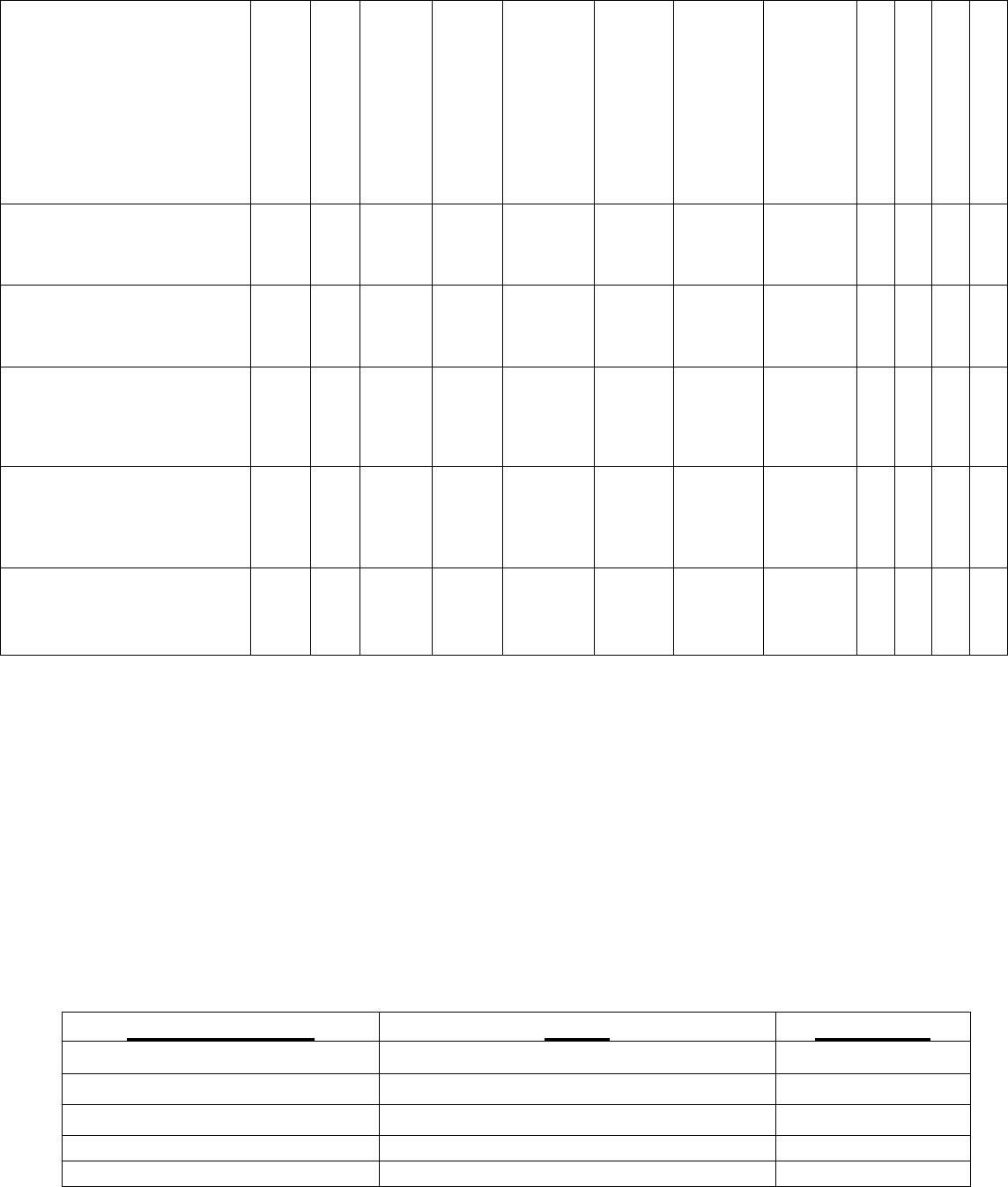
76
1. Tasks, Knowledge and
Technical References
Behavior Match
Core/Cert
Deployment * / SEI +
CBRN/TQT ♦
Trng
Start
Trng
Complete
Trainee
Initials
Trainer
Initials
Certifier
Initials
3-
lvl
5-
lvl
7-
lvl
9-
lvl
6.1.4.1. Author policy for
currency and coordinates for
validity
1
-
-
-
-
-
-
6.1.4.2. Collaborate with total
force partners for inclusive
policy
1
-
-
-
-
-
-
6.1.4.3. Audit existing policy
and provides recommended
changes to remedy potential
shortfalls
1
-
-
-
-
-
-
6.1.4.4. Develop and foster
relationships and open
communication within the
educational community
2
-
-
-
-
-
-
6.1.4.5. Ensure education
programs meet credentialing
standards
2
-
-
-
-
-
-
Section B
–Course Objective List
Section C - Support Material
There are currently no support material requirements.
Section D - Training Course Index
1.
Purpose.
This section of the CFETP identifies training courses available for the specialty
and shows how the courses are used by each MAJCOM in their career field training
programs.
2. Air Force In-Residence Courses:
COURSE NUMBER
TITLE
LOCATION
E3ALR3F231 01AC
Education and Training Apprentice
Keesler AFB
(*)3AIRTXXXX 0B1A
Basic Instructor Course
Each TTW
J3AZRTXXXX 0P1A
Principles of Instruction
Sheppard AFB
J3AZRTXXXX 0D1B
Instructional Systems Designer
Sheppard AFB
X3AIRXXXXX 0C1A
Computer Based Instruction (CBI) Designer
Goodfellow AFB

77
J4AIP3F2X1 DF3A
Technical Writer Principles
FTD
J3AIRTXXXX 0W1A
Technical Writer
Sheppard AFB
L3AIRTXXXX 0A1B
X3AIRTXXXX 0A1A
J3AIRTXXXX 0A1A
Analysis, Design, Development,
Implementation, and Evaluation (ADDIE)
Course
JBSA-Lackland
Goodfellow AFB
Sheppard AFB
(*) Indicates Multiple Training Locations
3. Air Force Distance Learning / Mobile Training:
4.
Other Training
CCAF Advisor’s Workshop. Contact CCAF at DSN 749-5021 for current class schedule.
Section E - MAJCOM Unique Requirements
1.
The following list of MAJCOM unique requirements are not all-inclusive; however, it
covers the most frequently referenced areas:
COURSE NUMBER
TITLE
LOCATION
J3AZRTXXXX 0D1B
INSTRUCTIONAL SYSTEMS DESIGN COURSE
SHEPPARD AFB
MTMC
MAINTENANCE TRAINING MANAGEMENT
COURSE
JB MCGUIRE DIX-
LAKEHURST, NJ
3J5ACC3S200 000
ACC CLASSROOM INSTRUCTOR COURSE
DYESS
3J5ACC3S200 001
ACC INSTRUCTOR METHODOLOGY COURSE
DYESS
3J5ACC3S200 002
ACC INSTRUCTIONAL SYSTEMS
DEVELOPMENT PRINCIPLES COURSE
DYESS
COURSE NUMBER
TITLE
Method of Delivery
J7AITTXXXX 0B3A
Basic Instructor Course
MTT
J7AZTTXXXX 0P1A
Principles of Instruction - Mobile Training Team
MTT/FTD
J7AZTTXXXX 0D1B
Instructional Systems Designer – Mobile Training
Team
MTT
J7AITTXXXX 0W1A
Technical Writer Course - Mobile Training Team
MTT
E6AIWTXXXX 0O1B
Instructor/Developer of Online Learning (IDOL)
DL
BFM 3F2X1 001
3F2 Base Functional Manager and Base Training
Manager Course
DL
L7AITTXXXX 0A1M
ADDIE (Analysis, Design, Development,
Implementation, and Evaluation)
MTT

78
355AZOXXXXX 005
39 IOS INSTRUCTIONAL SYSTEMS
DEVELOPMENT
HURLBURT FIELD
